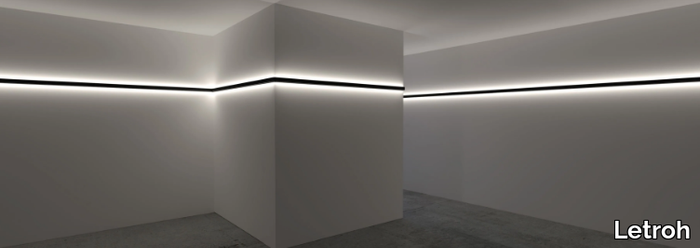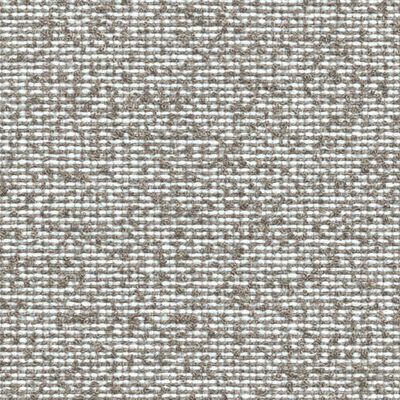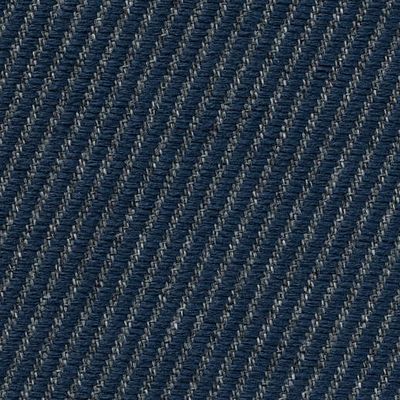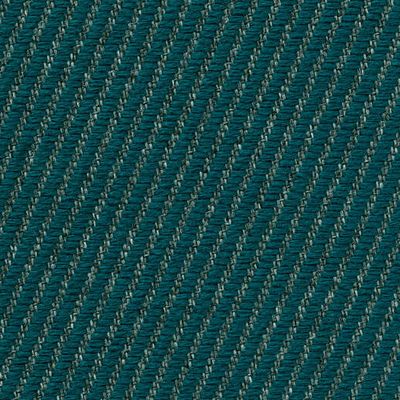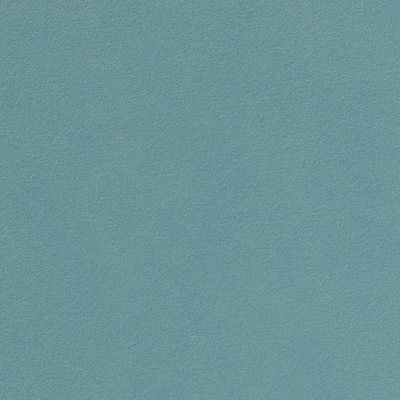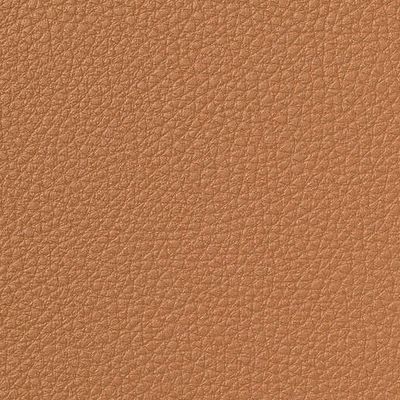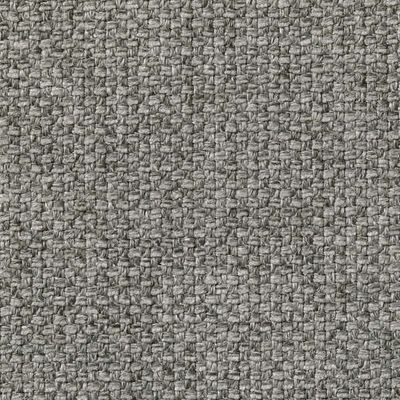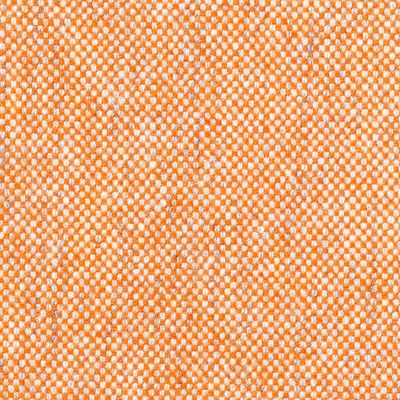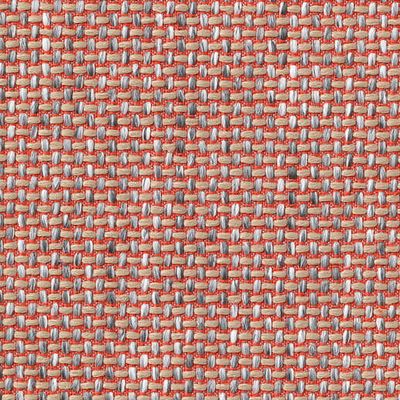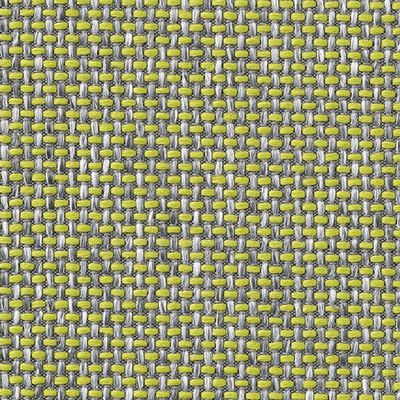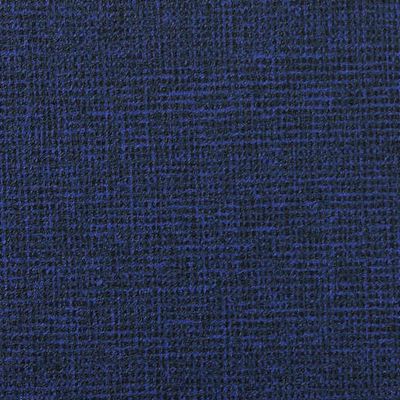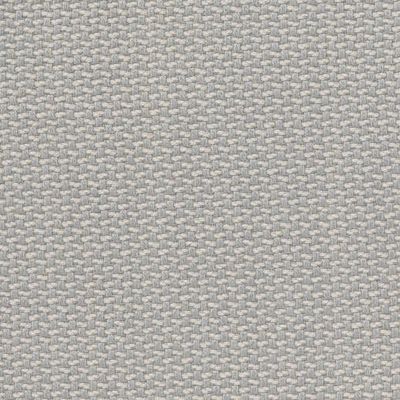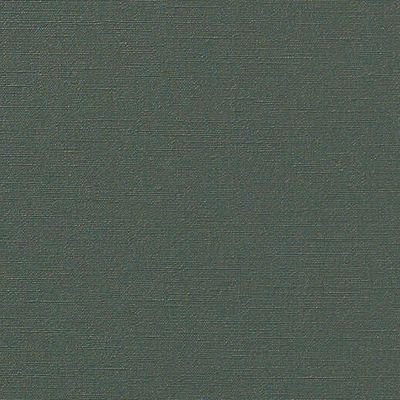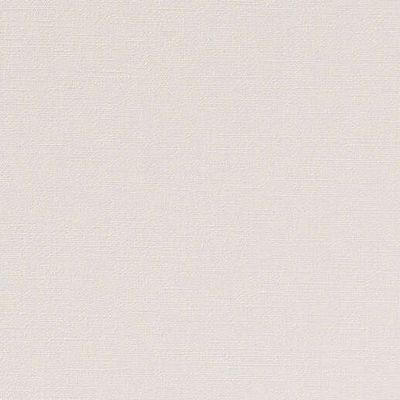VIAVAI LED BOARD - LED strip light _ Letroh - 2d files - 3d files
PRODUCT DESCRIPTION
**VIAVAI LED BOARD** is a sleek, linear LED module designed for seamless integration into mono or double-emission tracks, offering a continuous line of light with dimmable ON-OFF functionality. Built on an FR-4 PCB support, it features power and signal pickup contacts with a spring pusher for easy installation. Available in multiple wattages (9W, 13W, 17W) and color temperatures (2700K, 3000K), it delivers high-quality illumination with a CRI of 95 and IP20 insulation. The system is part of the innovative **VIAVAI 48V linear lighting range**, combining low-voltage track functionality with architectural lighting versatility—suitable for direct, indirect, wall-mounted, suspended, or recessed installation. Its slim profile, copper conductors in heat-resistant insulation (glow wire 850°C), and modular design (cuttable to size) ensure adaptability for any space. Choose from three variants: **MONO** (direct/suspended/recessed), **DUO W** (wall-mounted), or **DUO S** (suspended), in black or white epoxy finishes. A 3D file of the product is available for download to assist with planning and integration. **Supplier Insight:** Letroh is a U.S.-based interior design supplier (www.letroh.com) specializing in lighting, furniture, and decor for residential and commercial spaces, offering globally accessible, style-diverse solutions. *Key Features:* - Dimmable, high-CRI (95) LEDs - 108 LEDs/56cm, 48V operation - Lumen outputs: 1080lm–2088lm (varies by model) - Class III insulation, CE-certified - Snap-system installation, multi-point power delivery - Compatible with closing profiles, joints, and power supplies - Max capacity: 10A
SUPPLIER: LETROH
COLLECTION: VIAVAI
TYPE: LIGHTING

OTHER SUPPLIERS
A wide range of product from near to 3,000 suppliers around the world.


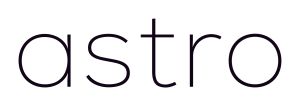
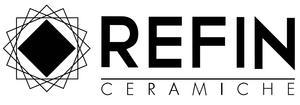


Other Products From This Supplier
A wide range of product from furniture to finishes to meet the desire of all designers.
VIAVAI BOB - Adjustable light source for aluminium track-Light _ Letroh
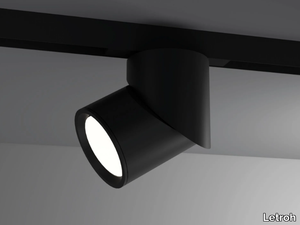
Letroh > Ceiling lamp
**VIAVAI BOB** is a versatile, adjustable LED spotlight featuring a double-joint design that enables 90° horizontal tilt and 360° vertical rotation, providing flexible lighting control. Crafted with a durable aluminum structure and integrated heat sink, it ensures efficient performance and longevity. The light source allows easy replacement of secondary lenses, with optics options including 30°, 40°, 60°, oval, rectangular, and Wallwasher, along with warm shade LEDs (2700K and 3000K, CRI 97). Compatible with multiple control systems (ON-OFF, 0-10V, DALI, DALI 2, CASAMBI), it offers dimmable functionality in select versions. The sleek design comes in white or black finishes, includes an adjustable cable, and meets IP20 and Class III safety standards (0.80 kg). A 3D file of the product is available for download, facilitating seamless integration into design plans. **Supplier Description:** Letroh is a leading interior design supplier specializing in high-quality lighting, furniture, and decor for residential and commercial spaces, with a global presence and a focus on innovative solutions. VIAVAI is part of a 48V linear lighting system, combining low-voltage track functionality with sleek linear profiles for architectural lighting. Ideal for direct or indirect illumination, it supports wall, ceiling, suspended, or recessed installation via multiple fixing systems. The modular design includes snap-in LED sources, copper conductors in fire-resistant insulation (glow wire 850°C), and customizable track lengths (cut-to-size by professionals). Available in MONO (direct/suspended/recessed), DUO W (wall-mounted), and DUO S (suspended) variants, it features a slim profile, black/white finishes, and supports up to 10A capacity. Additional components include closing profiles, joints, power supplies, and terminals for a polished finish.
VIAVAI ZOOM - Suspension for aluminium track-Light _ Letroh

Letroh > Ceiling lamp
**Product Description:** The **VIAVAI ZOOM** is a versatile suspension light source designed for architectural lighting, featuring an innovative snap-fastening system that allows effortless movement and addition of light sources. With adjustable optics ranging from 12 to 46 degrees, it ensures optimal light distribution for various settings. The sleek, painted aluminum body houses integrated electronics, available in multiple configurations: **ON-OFF, "ONE BY ONE" dimmable, 0-10V dimmable, and DALI dimmable**. **Technical Features:** - **ON-OFF Version:** 1 x 13W - 48V - **ONE BY ONE Dimmable:** 1 x 13W - 48V - **0-10V Dimmable:** 1 x 13W - 48V - **Color Options:** 2700K (CRI 97, 831/1010 lm) or 3000K (CRI 97, 878/1068 lm) - **Finishes:** White or Black - **Adjustable Optic:** 12°–46° - **Converter Included** - **Adjustable Cable** - **Insulation Class III, IP20** - **Weight:** 0.42 kg Part of the **VIAVAI** 48V linear lighting system, this product combines the flexibility of low-voltage tracks with the sleek design of linear profiles, suitable for direct, indirect, suspended, or recessed installation. The system features copper conductors in an insulated profile, supports multiple configurations (MONO, DUO W, DUO S), and can be cut to size by a qualified technician. A **3D file of the product is available for download**, facilitating seamless integration into design plans. **Supplier Description:** Letroh is a U.S.-based interior design supplier offering a curated selection of lighting, furniture, and decor for residential and commercial spaces, available globally through their website, [www.letroh.com](http://www.letroh.com).
VIAVAI ZOOM - Fixed source for aluminium track-Light _ Letroh

Letroh > Ceiling lamp
**Product Description:** The **VIAVAI ZOOM** is a versatile fixed light source designed for seamless integration into the **VIAVAI 48V linear lighting system**. Featuring an innovative snap-fastening mechanism, the ZOOM light sources can be effortlessly moved, repositioned, or added along the track for customizable illumination. Its adjustable optics (12° to 46°) allow precise control over the light beam, ensuring optimal adaptation for various lighting effects. The sleek, painted aluminum body houses high-performance LED modules, available in multiple dimming options—**ON-OFF, 0-10V, DALI, and "ONE BY ONE"**—providing flexibility for different lighting control systems. With a **CRI of 97** and warm color temperatures (**2700K or 3000K**), it delivers exceptional light quality (up to **1068 lm**). The **IP20-rated** fixture includes an integrated converter and comes in **white or black finishes**, making it ideal for both residential and commercial architectural lighting. For added convenience, a **3D file of the product is available for download**, facilitating seamless integration into design plans. **Supplier Description:** Letroh is a leading interior design supplier specializing in high-quality lighting, furniture, and decor for both residential and commercial spaces, with a strong global presence. The **VIAVAI system** is a groundbreaking **48V low-voltage lighting solution**, combining the flexibility of track lighting with the sleek aesthetics of linear profiles. Designed for **direct, indirect, suspended, or recessed installation**, it supports multiple configurations (**MONO, DUO W, DUO S**) to suit diverse architectural needs. Its **ultra-slim profile**, **glow-wire insulated copper conductors (850°C rated)**, and modular design allow for easy customization, including on-site cutting by professionals. With **10A max capacity** and **CE certification**, VIAVAI ensures both performance and safety, making it a top choice for modern lighting design.
VIAVAI ZOOM - Adjustable source for aluminium track-Light _ Letroh

Letroh > Ceiling lamp
**VIAVAI ZOOM** is a versatile, adjustable light source designed for architectural lighting, featuring a user-friendly snap-fastening system that allows effortless movement and addition of light modules. Its adjustable optics (12° to 46°) provide optimal light beam control, while the painted aluminum body ensures durability. Available in multiple dimming options—ON/OFF, 0-10V, and DALI—it delivers high-quality illumination with 2700K (CRI 97, 831/1010 lm) and 3000K (CRI 97, 878/1068 lm) options in white or black finishes. The integrated 48V system includes a converter, adheres to IP20 and Class III standards, and weighs just 0.33 kg. Part of the **VIAVAI** line, it combines low-voltage track functionality with sleek linear profiles, suitable for direct, indirect, wall-mounted, suspended, or recessed installation. A 3D file of the product is available for download, aiding in seamless integration into design plans. **Supplier:** Letroh is a global interior design supplier known for its diverse range of high-quality lighting, furniture, and decor, available at various price points to suit different project needs. Explore their offerings at [www.letroh.com](http://www.letroh.com).
VIAVAI MINI - Suspension for aluminium track-Light _ Letroh
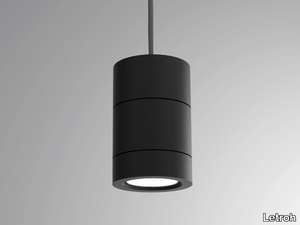
Letroh > Ceiling lamp
**Product Description:** The **VIVAI MINI** is a sleek and versatile suspension light source designed for flexibility and ease of use. Its compact design allows for effortless movement and customization, thanks to an intuitive snap-fastening system. The light features a painted aluminum body and offers easy replacement of secondary optics. Available in multiple dimming options—including "ONE BY ONE," ON-OFF, 0-10V dimmable, and DALI dimmable versions—it provides adaptable lighting solutions for various settings. **Technical Specifications:** - **Power:** 1 x 9W - 48V - **Color Temperatures:** 2700K (CRI 97, 728 lm) / 3000K (CRI 97, 770 lm) - **Finishes:** White or Black - **Includes:** Lenses, converter, adjustable cave - **Certifications:** IP20, CE, Insulation Class III - **Weight:** 0.23 kg The **VIAVAI** system, to which the MINI belongs, is a cutting-edge 48V linear lighting solution that merges the functionality of low-voltage tracks with the elegance of architectural lighting. It supports direct, indirect, suspended, or recessed installation, with multiple fixing options for seamless integration. The system features copper conductors in an insulated profile, supports customizable lengths, and comes in MONO, DUO W, and DUO S variants for diverse applications. A **3D file of the product is available for download**, facilitating easy planning and integration into design projects. **Supplier Description:** Letroh is a leading interior design supplier specializing in high-quality lighting, furniture, and decor for both residential and commercial spaces, with a strong global presence.
VIAVAI MINI - Fixed light source for aluminium track-Light _ Letroh

Letroh > Ceiling lamp
**Product Description:** The **VIVAI MINI** is a sleek, fixed light source featuring a diffuser, designed for effortless flexibility with its compact, snap-fastening system that allows easy movement and addition of modules. The secondary optics are simple to replace, and its durable painted aluminum body ensures longevity. Available in multiple integrated electronic configurations—**ON-OFF, "ONE BY ONE" dimmable, 0-10V dimmable, and DALI dimmable**—it offers versatile lighting control. **Technical Features:** - **ON-OFF Version:** 1 x 9W - 48V - **ONE BY ONE Dimmable:** 1 x 9W - 48V - **0-10V Dimmable:** 1 x 9W - 48V - **Color Options:** 2700K (CRI 97, 728 lm) / 3000K (CRI 97, 770 lm) - **Finishes:** White or Black - **Includes:** Lenses (to be completed), converter - **Insulation Class:** III / IP20 - **Weight:** 0.11 kg Part of the **VIAVAI** 48V linear lighting system, the **VIVAI MINI** combines the adaptability of low-voltage tracks with the sleekness of linear profiles, ideal for both direct and indirect architectural lighting. The system supports multiple installation methods—wall-mounted, suspended, or recessed—and features copper conductors in a high-temperature-resistant insulating profile. With customizable lengths and a minimalist design, **VIAVAI** ensures seamless integration into any space. A **3D file of the product is available for download**, facilitating easy planning and integration into design projects. **Supplier Description:** Letroh is a U.S.-based interior design supplier known for its diverse range of high-quality lighting, furniture, and décor for residential and commercial spaces, available globally through their website, [www.letroh.com](http://www.letroh.com).
VIAVAI MINI - Suspension for aluminium track-Light _ Letroh
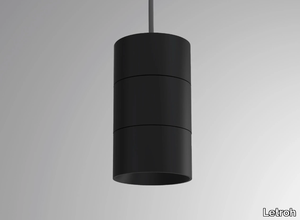
Letroh > Ceiling lamp
**Product Description:** The **VIVAI MINI** is a sleek, suspension-mounted dark light source designed for flexibility and ease of use. Compact and modular, these fixtures can be effortlessly repositioned or expanded thanks to an intuitive snap-fastening system. The secondary optics are easily replaceable, allowing for customization, while the durable painted aluminum body ensures longevity. Available in multiple integrated electronic configurations—including ON/OFF, 0-10V dimmable, and DALI dimmable versions—the VIVAI MINI adapts to various lighting needs. **Technical Features:** - **ON-OFF Version:** 1 x 9W - 48V - **ONE BY ONE Dimmable:** 1 x 9W - 48V - **0-10V Dimmable:** 1 x 9W - 48V - **Color Options:** 2700K (CRI 97, 698 lm) or 3000K (CRI 97, 740 lm) - **Finishes:** White or Black - **Included Accessories:** 20° lens, honeycomb diffuser, converter - **Adjustable cave for precise light direction** - **Insulation Class III, IP20, CE Certified** - **Weight:** 0.25 kg Part of the **VIAVAI** 48V linear lighting system, the MINI integrates seamlessly into this innovative architectural lighting solution, which combines the adaptability of low-voltage tracks with the elegance of linear profiles. The system supports direct, indirect, suspended, or recessed installation, with multiple mounting options and copper conductors embedded in high-temperature-resistant insulation. A 3D file of the product is available for download, facilitating seamless integration into design plans. **Supplier Description:** Letroh is a leading interior design supplier offering high-quality lighting, furniture, and decor for residential and commercial spaces, with a global presence headquartered in the US. Explore their collection at [www.letroh.com](http://www.letroh.com).
VIAVAI MINI - Suspension for aluminium track-Light _ Letroh
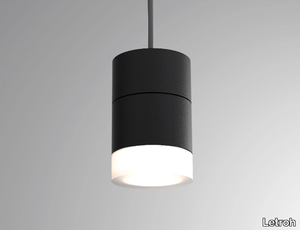
Letroh > Ceiling lamp
**Product Description:** The **VIVAI MINI** is a sleek, suspended dark light source designed for flexibility and ease of use. Its compact design allows for effortless movement and positioning, thanks to an intuitive snap-fastening system. The fixture features a painted aluminum body and offers easy replacement of secondary optics for customizable lighting. Available in multiple dimming options—**ON-OFF, 0-10V dimmable, and DALI dimmable**—it provides versatile control for any setting. Technical specifications include a **9W - 48V LED** with high CRI (97) in **2700K (698 lm) or 3000K (740 lm)**, ensuring excellent color rendering. Finishes come in **white or black**, and the product includes an adjustable cave, converter, and optional lenses for tailored illumination. With an **IP20 rating and Class III insulation**, it’s both safe and durable. A **3D file of the product is available for download**, aiding in seamless integration into design plans. **Supplier Description:** Letroh is a trusted interior design supplier specializing in high-quality lighting, furniture, and decor for residential and commercial spaces, with a global presence and a focus on innovative solutions. **Additional Product Details:** Part of the **VIAVAI 48V linear lighting system**, the VIVAI MINI combines the adaptability of low-voltage tracks with the sleekness of linear profiles, ideal for both direct and indirect lighting. The system supports multiple installation methods—wall-mounted, suspended, or recessed—and features copper conductors in a fire-resistant insulating profile (glow wire 850°C). With **MONO, DUO W, and DUO S variants**, it accommodates diverse layouts and can be cut to size by professionals. The minimalist design, available in **black or white**, ensures seamless integration into modern interiors while maximizing functionality.
VIAVAI MINI - Fixed light source for aluminium track-Light _ Letroh
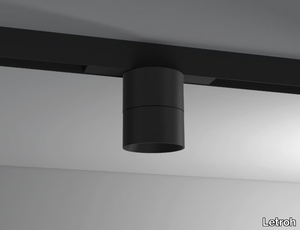
Letroh > Ceiling lamp
**Product Description:** The **VIVAI MINI** is a compact, fixed dark light source designed for effortless flexibility, featuring a snap-fastening system that allows easy movement and addition of modules. Its secondary optics can be quickly replaced, and the sleek painted aluminum body houses integrated electronics available in multiple versions: **ON-OFF, "ONE BY ONE" dimmable, 0-10V dimmable, and DALI dimmable**. **Technical Features:** - **Power & Voltage:** 1 x 9W - 48V - **Color Options:** 2700K (CRI 97, 698 lm) or 3000K (CRI 97, 740 lm) - **Finishes:** White or Black - **Included Accessories:** 20° lens, honeycomb diffuser, and converter - **Certifications:** IP20, CE-rated - **Weight:** 0.14 kg Part of the **VIAVAI 48V linear lighting system**, the MINI combines the adaptability of low-voltage tracks with the sleekness of linear profiles, ideal for both direct and indirect ambient lighting. The system supports wall, ceiling, suspended, or recessed installation with multiple fixing options and includes copper conductors in high-temperature-resistant insulation (glow wire 850°C). Customizable with closing profiles, joints, and power supplies, VIAVAI can be cut to size and is available in **MONO, DUO W (wall-mounted), and DUO S (suspended)** variants, all in black or white finishes. **3D File Available:** A downloadable 3D model of the product is provided for precise planning and integration into design projects. **Supplier Description:** Letroh is a global interior design supplier known for its diverse range of high-quality lighting, furniture, and decor, blending innovation with functionality. (Learn more: [www.letroh.com](http://www.letroh.com))
VIAVAI MINI - Fixed light source for aluminium track-Light _ Letroh

Letroh > Ceiling lamp
**VIVAI MINI** is a compact, fixed light source designed for effortless flexibility, featuring a snap-fastening system that allows for easy movement and addition of modules. Its aluminum body comes in white or black finishes, with replaceable secondary optics for customizable lighting. The integrated electronics offer multiple control options, including ON-OFF, 0-10V dimming, and DALI dimming, with a 9W - 48V power supply. Available in 2700K (CRI 97, 728 lm) or 3000K (CRI 97, 770 lm), it includes lenses and a converter, meeting IP20 and Class III safety standards. A downloadable 3D file of the product is available for design integration. **Supplier:** Letroh is a leading interior design supplier offering innovative lighting solutions, including the VIVAI line, known for its cutting-edge architectural lighting systems. Explore their products at [www.letroh.com](http://www.letroh.com). Part of the **VIAVAI** 48V linear lighting system, the MINI integrates seamlessly into tracks designed for direct, indirect, suspended, or recessed installation. The system features copper conductors in an insulated profile, supports multiple configurations (MONO, DUO W, DUO S), and allows for custom cuts by qualified technicians. With a sleek, low-profile design and versatile mounting options, VIAVAI combines functionality with aesthetic precision, available in black or white epoxy finishes.
VIAVAI MINI - Adjustable light source for aluminium track-Light _ Letroh

Letroh > Ceiling lamp
**Product Description:** The **VIVAI MINI** is a compact and adjustable dark light source designed for seamless integration and flexibility in architectural lighting. Featuring a snap-fastening system, it allows for effortless movement and addition of light sources, while secondary optics can be easily replaced. The durable painted aluminum body houses integrated electronics, available in multiple versions: **ON-OFF, 0-10V dimmable, and DALI dimmable**. With a high CRI of 97, it delivers excellent light quality (2700K – 698 lm / 3000K – 740 lm) and includes a 20° lens and honeycomb for precise beam control. The **Class III IP20-rated** fixture comes in white or black finishes and includes a converter, weighing just 0.14 kg. A **3D file of the product is available for download**, facilitating easy integration into design plans. Part of the **VIAVAI 48V linear lighting system**, the VIVAI MINI combines the adaptability of low-voltage tracks with the sleek functionality of linear profiles. Ideal for both direct and indirect lighting, it supports multiple installation methods—wall-mounted, suspended, or recessed—with an innovative snap-in mechanism for effortless light source placement. The system features copper conductors in high-temperature-resistant insulation, customizable cutting, and multiple closing profiles for a clean aesthetic. Available in **MONO, DUO W (wall), and DUO S (suspended)** variants, it maximizes versatility with a slim profile and 10A capacity. **Supplier Description:** Letroh is a U.S.-based interior design supplier known for its high-quality lighting, furniture, and decor, catering to both residential and commercial spaces. For more details, visit [www.letroh.com](http://www.letroh.com).
VIAVAI MINI - LED aluminium track-Light _ Letroh
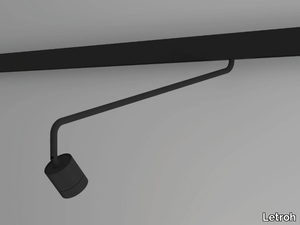
Letroh > Ceiling lamp
**VIVAI MINI Wall Light** The **VIVAI MINI** is a sleek and versatile wall-mounted light source, designed for flexibility and ease of use. Its compact size allows for effortless repositioning and addition thanks to an intuitive snap-fastening system, while the secondary optics can be quickly replaced as needed. Crafted from durable painted aluminum, it features integrated electronics with multiple control options, including **ON-OFF, 0-10V dimmable, and DALI dimmable** versions. **Technical Specifications:** - **Power:** 1 x 9W - 48V - **Color Temperatures:** 2700K (CRI 97, 728 lm) / 3000K (CRI 97, 770 lm) - **Finishes:** White or Black - **Insulation Class:** III / IP20 - **Weight:** 0.30 kg Part of the **VIAVAI** 48V linear lighting system, the MINI combines the adaptability of low-voltage tracks with the sleek aesthetics of modern architectural lighting. The system supports various installation methods—wall-mounted, suspended, or recessed—and includes copper conductors in a high-temperature-resistant insulating profile. A **3D file of the product is available for download**, facilitating seamless integration into design plans. **Supplier Overview:** Letroh is a leading interior design supplier offering high-quality lighting, furniture, and décor for residential and commercial spaces, with a global presence and a focus on innovative solutions. Explore their collection at [www.letroh.com](http://www.letroh.com).
VIAVAI MINI - Adjustable light source for aluminium track-Light _ Letroh

Letroh > Ceiling lamp
**Product Description:** The **VIVAI MINI** is a versatile, adjustable light source designed for flexibility and ease of use. Its compact design allows for effortless movement and positioning, thanks to a convenient snap-fastening system. The secondary optics can be easily replaced, and the durable painted aluminum body ensures longevity. Available in multiple configurations—including **ON-OFF, 0-10V dimmable, and DALI dimmable versions**—it offers seamless integration into various lighting setups. **Technical Features:** - **Power:** 1 x 9W - 48V - **Color Temperatures:** 2700K (CRI 97, 728 lm) / 3000K (CRI 97, 770 lm) - **Finishes:** White or Black - **Includes lenses and converter** - **Insulation Class III, IP20, CE certified** - **Weight:** 0.12 kg Part of the **VIAVAI 48V linear lighting system**, the VIVAI MINI combines the adaptability of low-voltage tracks with the sleekness of linear profiles, making it ideal for both direct and indirect lighting in residential and commercial spaces. The system supports multiple installation methods—wall-mounted, suspended, or recessed—and features copper conductors in a high-temperature-resistant insulating profile. A **3D file of the product is available for download**, allowing for precise planning and integration into design projects. **Supplier Description:** Letroh is a leading interior design supplier offering high-quality lighting, furniture, and decor for home and commercial spaces, with a global presence and a focus on innovative solutions. Explore their collection at [www.letroh.com](http://www.letroh.com).
VIAVAI LED BOARD - LED strip light _ Letroh

Letroh > Lighting accessories
**VIAVAI LED BOARD** is a sleek, linear LED module designed for seamless integration into mono or double-emission tracks, offering a continuous line of light with dimmable ON-OFF functionality. Built on an FR-4 PCB support, it features power and signal pickup contacts with a spring pusher for easy installation. Available in multiple wattages (9W, 13W, 17W) and color temperatures (2700K, 3000K), it delivers high-quality illumination with a CRI of 95 and IP20 insulation. The system is part of the innovative **VIAVAI 48V linear lighting range**, combining low-voltage track functionality with architectural lighting versatility—suitable for direct, indirect, wall-mounted, suspended, or recessed installation. Its slim profile, copper conductors in heat-resistant insulation (glow wire 850°C), and modular design (cuttable to size) ensure adaptability for any space. Choose from three variants: **MONO** (direct/suspended/recessed), **DUO W** (wall-mounted), or **DUO S** (suspended), in black or white epoxy finishes. A 3D file of the product is available for download to assist with planning and integration. **Supplier Insight:** Letroh is a U.S.-based interior design supplier (www.letroh.com) specializing in lighting, furniture, and decor for residential and commercial spaces, offering globally accessible, style-diverse solutions. *Key Features:* - Dimmable, high-CRI (95) LEDs - 108 LEDs/56cm, 48V operation - Lumen outputs: 1080lm–2088lm (varies by model) - Class III insulation, CE-certified - Snap-system installation, multi-point power delivery - Compatible with closing profiles, joints, and power supplies - Max capacity: 10A
VIAVAI LED BOARD - LED strip light _ Letroh
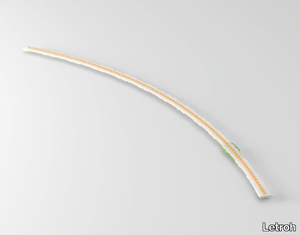
Letroh > Lighting accessories
**VIAVAI LED BOARD** is a sleek, curved LED board module featuring dimmable ON-OFF functionality, perfect for creating seamless lines of light in single or double-emission tracks. Crafted with an FR-4 PCB support, it includes power and signal pickup contacts with a spring pusher for easy installation. The board is available in multiple configurations, offering high CRI 95 lighting with varying wattages (12W, 16W, 24W) and color temperatures (2700K, 3000K) to suit different ambiance needs. With IP20 insulation, CE certification, and a lightweight design (0.20 kg), it ensures both performance and safety. Part of the innovative **VIAVAI 48V linear lighting system**, this product combines low-voltage track functionality with architectural lighting versatility, ideal for direct, indirect, wall-mounted, suspended, or recessed installations. The system features copper conductors in a high-temperature-resistant insulating profile (glow wire 850°C), snap-in LED sources, and customizable track lengths (cuttable by professionals). Available in **MONO**, **DUO W**, and **DUO S** variants with black or white epoxy finishes, it maximizes aesthetic flexibility while maintaining a slim profile. A downloadable **3D file** of the product is available for design integration. **Supplier:** Letroh is a global interior design supplier specializing in modern lighting, furniture, and decor, offering high-quality solutions for residential and commercial spaces. Explore their collection at [www.letroh.com](http://www.letroh.com).
VIAVAI DUO - Extruded aluminium track-Light system _ Letroh

Letroh > Accessories
Here’s your rephrased and expanded product description, including a concise supplier overview and mention of the 3D file availability: --- The **VIAVAI DUO track** is crafted from extruded aluminum with a durable epoxy paint finish, available in sleek black or white, and can be custom-cut to fit any space. Designed for versatility, it offers both wall-mounted and suspended installation options, supporting a maximum capacity of 10A per line. As part of the innovative **VIAVAI 48V linear lighting system**, it combines the efficiency of low-voltage tracks with the seamless integration of linear profiles, making it ideal for direct or indirect ambient lighting. The system features an intuitive snap-in mechanism for effortless installation of LED sources, which can be powered at any point along the track. With multiple mounting options—including direct ceiling or wall attachment, suspension, or recessed installation—VIAVAI DUO adapts to diverse design needs. The track includes copper conductors housed in high-temperature-resistant insulation (glow wire 850°C), along with optional closing profiles, joints, and power supplies for a polished finish. A **3D file of the product is available for download**, enabling precise planning and integration into projects. **Supplier Overview**: Letroh is a U.S.-based interior design supplier known for its curated selection of lighting, furniture, and decor, catering to both residential and commercial spaces. Available in three variants—**MONO** (direct, suspended, or recessed), **DUO W** (wall-mounted), and **DUO S** (suspended)—VIAVAI blends cutting-edge technology with a minimalist profile for unmatched versatility and aesthetic appeal. For detailed specifications, visit the manufacturer’s page on **VIAVAI DUO by Letroh**. --- This version keeps the technical details intact while improving flow, adding the 3D file note, and condensing the supplier info to one sentence. Let me know if you'd like any further refinements!
NODO MINI - LED adjustable aluminium reading lamp _ Letroh

Letroh > Ceiling lamp
**NODO MINI** is an adjustable reading light designed for both functionality and sleek aesthetics. Its technical features include a 9W - 230V power supply (included), delivering warm 3000K lighting with high CRI 97 for excellent color rendering and 740 lm brightness. The light comes with a 20° lens and honeycomb attachment for focused illumination and is available in white or black finishes. Though non-dimmable, it features an ON/OFF switch and an integrated shuttle device for seamless connection to compatible track systems. A 3D file of the product is available for download, allowing for easy integration into design plans. Part of the innovative **NODO track system**, this light embodies flexibility in architectural design, enabling tool-free adjustment and repositioning of sockets, fixtures, and accessories. The system reduces the need for extensive masonry work while offering creative freedom to adapt spaces dynamically. **Supplier**: Letroh is a trusted interior design supplier known for its diverse range of modern and functional lighting, furniture, and decor, available globally through its website, [www.letroh.com](http://www.letroh.com).
VIAVAI MONO - Extruded aluminium track-Light system _ Letroh
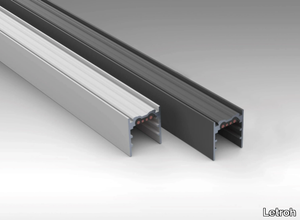
Letroh > Accessories
Here’s a refined and expanded product description, including a brief supplier overview and mention of the 3D file availability: **Product Description:** The **VIAVAI MONO track** is crafted from high-quality extruded aluminum, featuring a sleek epoxy paint finish in black or white, designed to blend seamlessly into modern interiors. Its versatile design allows for direct wall or ceiling mounting, suspension, or recessed installation, supported by four distinct fixing systems for flexible placement. With a maximum capacity of 10A, this 48V linear lighting system merges the functionality of low-voltage tracks with the elegance of architectural lighting profiles. The innovative snap-system ensures effortless installation of LED light sources, while copper conductors housed in heat-resistant insulation (glow wire 850°C) guarantee safety and durability. Customizable with closing profiles, joints, and power supplies, VIAVAI MONO can be cut to size by a professional for tailored solutions. Available in three variants—**MONO** (direct/suspended/recessed), **DUO W** (wall-mounted), and **DUO S** (suspended)—this system excels in both direct and indirect lighting applications. For added convenience, a **3D file of the product is available for download**, enabling precise planning and integration into your design projects. **Supplier Overview:** Letroh is a globally recognized interior design supplier, headquartered in the U.S., offering innovative lighting solutions like VIAVAI alongside furniture and decor for residential and commercial spaces. *(Note: Adjusted to one sentence as requested.)*
NODO HOOK - Aluminium coat rack _ Letroh
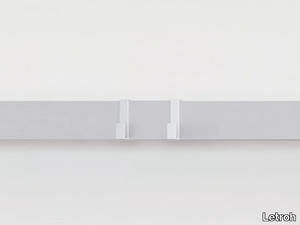
Letroh > Accessories
Here’s the rephrased and expanded product description, including a concise supplier overview and mention of the 3D file availability: **Product Description:** The **NODO Hook** is designed for use exclusively with wall-mounted NODO tracks, offering a sleek and functional solution for organizing your workspace with a maximum load capacity of 300 grams. Available in three elegant finishes—Silver, White, and Black—this lightweight (0.02 kg) accessory seamlessly integrates into the **NODO system**, a versatile track that allows tool-free repositioning of sockets, lighting, and other accessories to adapt to your evolving needs. Alongside other NODO components like the **Shelf** and **Roll Holder**, the Hook helps declutter your environment, while the customizable **Dust/Steam Seal** adds further utility. The NODO Shelf, with its ergonomic profile, can even hold tablets up to 12.9 inches. As part of an innovative electrical and design system, NODO eliminates the constraints of traditional wiring, enabling creative freedom and cost savings by reducing construction work. A downloadable **3D file** of the product is available for preview or integration into design plans. **Supplier Overview:** Letroh, a U.S.-based interior design supplier, offers a diverse range of functional and aesthetic solutions for residential and commercial spaces, including the NODO system. Explore their collection at [www.letroh.com](http://www.letroh.com). *(Note: Adjusted to one sentence as requested while retaining key details.)*
NODO SHELF - Aluminium wall shelf _ Letroh
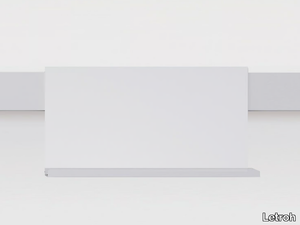
Letroh > Cabinet
Here’s your rephrased and expanded product description, including a concise supplier overview and mention of the 3D file availability: **Product Description:** The NODO Shelf is a sleek and functional accessory designed exclusively for wall-mounted NODO tracks, offering a convenient storage solution with a maximum load capacity of 1.5 kg. Available in three elegant finishes—Silver, White, and Black—this shelf integrates seamlessly into the NODO system, enhancing workspace organization by minimizing clutter. Its versatile profile can securely hold objects like tablets up to 12.9 inches, while complementary accessories such as the HOOK, ROLL HOLDER, and customizable DUST/STEAM SEAL further expand its utility. As part of the innovative NODO track system, this shelf aligns with the brand’s vision of adaptable, tool-free design, allowing users to redefine their spaces creatively and efficiently. A downloadable 3D file of the product is available for detailed preview or integration into design plans. For additional specifications, refer to the manufacturer, Letroh—a globally recognized interior design supplier known for blending aesthetics with functionality across residential and commercial spaces. *(Note: The supplier description is condensed to one sentence while retaining key details about Letroh’s expertise and reach.)*
NODO NUO - Light source for aluminium track-Light _ Letroh

Letroh > Ceiling lamp
Here’s your rephrased and expanded product description, including a concise supplier overview and mention of the 3D file: **NODO NUO** is an elegant, glare-free reading light featuring a built-in diffuser, available in both left and right-handed versions. Crafted with a sleek, flexible arm wrapped in anthracite grey fabric, it combines functionality with modern design. The light is constructed from anodized aluminum, ensuring durability and efficient heat dissipation. Equipped with an integrated Shuttle device, it seamlessly connects to compatible track systems, while the touch switch allows for effortless operation and adjustable LED light diffusion (4.5W, 3000K, CRI 90, 400 lumens). The power supply is integrated, and the fixture is dimmable, offering finishes in silver, white, or black. A downloadable 3D file of the product is available for design planning. **Supplier Overview:** Letroh is a U.S.-based interior design supplier known for its innovative lighting and furniture solutions, catering to both residential and commercial spaces. Part of the **NODO track system**, this light embodies flexibility—allowing tools-free repositioning of sockets, lighting, and accessories to adapt to evolving spaces. The system reduces construction needs while offering creative freedom in layout changes. For more details, visit the manufacturer’s page on Letroh’s website, [www.letroh.com](http://www.letroh.com).
NODO BOB - Adjustable light source for aluminium track-Light _ Letroh

Letroh > Ceiling lamp
**Product Description:** The **NODO BOB** is an adjustable GU10 LED spotlight featuring a double-joint design that allows 90° tilt on the horizontal plane and 360° rotation around the vertical axis, providing flexible directional lighting. With an aluminum structure and integrated heat sink, it ensures durability and efficient heat dissipation. The spotlight has a maximum power of 10W (230V), is available in white or black finishes, and has an IP20 rating. A key feature is the easy replacement of its secondary lens, allowing for customization. As part of the **NODO** system—an innovative, tool-free track lighting solution—BOB enables effortless repositioning of fixtures at any time. The NODO system eliminates the need for invasive wiring or masonry work, offering a three-phase solution: **Project** (modifiable socket placement), **Installation** (quick, safe connections with Smart-ON), and **Use** (tool-free adjustments via an intuitive shuttle system). A downloadable **3D file** of the product is available for detailed planning and integration into design projects. **Supplier Description:** Letroh is a U.S.-based interior design supplier specializing in modern lighting, furniture, and decor for residential and commercial spaces, offering a blend of style and functionality. Explore their collection at [www.letroh.com](http://www.letroh.com).
NODO BOB - Adjustable LED light source for aluminium track-Light _ Letroh

Letroh > Ceiling lamp
**Product Description:** The **NODO BOB** is an adjustable LED spotlight featuring a high-performance 20W LED (230V) with two color temperature options—2700K (1800 lm) and 3000K (1900 lm)—both boasting an exceptional CRI of 97 for vibrant, true-to-life illumination. Available in sleek White or Black finishes, it requires optional lenses and a power supply for full functionality. The spotlight is dimmable (cut-phase) and has an IP20 rating, making it ideal for indoor use. With an aluminum body and integrated heat sink, the **BOB** ensures durability and efficient heat dissipation. Its innovative double-joint design allows 90° tilt on the horizontal plane and 360° rotation on the vertical axis, offering flexible directional lighting. The secondary lens is easily replaceable, adding to its user-friendly design. Part of the **NODO** system—an innovative, tool-free track lighting solution—the **BOB** enables effortless repositioning of fixtures at any time, eliminating the need for structural modifications. The **NODO** system is designed for seamless integration in three phases: **Project** (adjustable socket placement without wall ducts), **Installation** (quick Smart-ON connections), and **Use** (effortless reconfiguration with a shuttle system). A downloadable **3D file** of the product is available for design planning. **Supplier Description:** Letroh is a leading interior design supplier offering high-quality lighting, furniture, and decor for residential and commercial spaces, with a focus on innovation and functionality. Explore their collection at [www.letroh.com](http://www.letroh.com).
NODO MICROLED - Aluminium LED light bar _ Letroh
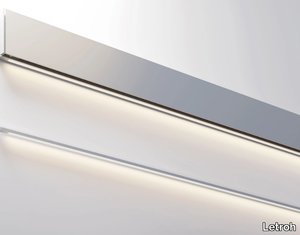
Letroh > Lighting accessories
**NODO MICROLED** is a sleek and versatile aluminum LED profile designed for modern lighting solutions, featuring 180 LEDs per meter, 11W/m power consumption, and 24V operation. Available in lengths of 100cm, 200cm, or 300cm, it delivers a warm 3000K color temperature with 1100 lm/m brightness and comes in a stylish silver finish, with custom sizes available upon request. This dimmable, IP20-rated profile adheres effortlessly to tracks using integrated double-sided tape, and its electrical installation remains independent of the system for added convenience. NODO represents a subtle yet revolutionary approach to lighting, offering a flexible, tool-free solution for positioning and adjusting fixtures anytime. Its **3-phase system** ensures adaptability: - **Phase 1 (Project):** Modify socket placements even post-installation without wall ducts or structural changes, thanks to its ultra-flat design. - **Phase 2 (Installation):** Features the Smart-ON system for quick, safe connections—no specialized training required. - **Phase 3 (Use):** Effortlessly reposition sockets, lights, and accessories using the intuitive shuttle system, eliminating the need for masonry work. A **3D file of the product is available for download**, allowing for seamless integration into design plans. **Supplier Overview:** Letroh is a trusted interior design supplier specializing in high-quality lighting, furniture, and decor for residential and commercial spaces, with a global presence and a focus on innovative solutions. Explore more at [www.letroh.com](http://www.letroh.com).
NODO PLUG-IN - Electric track for repositionable sockets _ Letroh

Letroh > Ceiling lamp
Here’s the rephrased and expanded product description, including a concise supplier overview and mention of the 3D file availability: **NODO PLUG-IN** is a versatile and ready-to-use aluminum track kit featuring pre-assembled wiring with a plug, terminals, and wall supports, available in left and right configurations. Designed for effortless installation, it eliminates the need for a dedicated wall power point—simply connect it to a nearby outlet using the included 200cm cable, and the system is instantly operational. Perfect for flexible lighting and power solutions, the kit integrates seamlessly with **NODO BOX sockets**, accessories, and **MINI or NUO reading lamps**. Customize your setup with length options (100/150/200/250/300 cm) and finishes (Silver/White/Black), all meeting IP20 and CE standards (1 kg per 100 cm). The innovative NODO track system redefines architectural design, enabling tool-free adjustments of sockets, lights, and accessories for creative, cost-effective spaces. **A 3D file of the product is available for download**, aiding in planning and integration. **Supplier Overview**: Letroh is a global interior design supplier (headquartered in the U.S.) known for its curated range of modern, functional products for residential and commercial spaces. Explore their offerings at [www.letroh.com](http://www.letroh.com).
NODO ZOOM - Adjustable LED light source for aluminium track-Light _ Letroh

Letroh > Ceiling lamp
**NODO ZOOM** is an adjustable lighting source featuring a rotating zoom optic (patent pending) that allows seamless beam adjustment from 12° to 46°, with high-quality LEDs available in 2700K and 3000K color temperatures and an exceptional CRI 97 for vibrant, natural illumination. Technical specifications include a 13W - 230V power supply, dimmable cut-phase functionality, and finishes in white or black, all while maintaining a lightweight design at just 0.44 kg (IP20 rated). The product also includes a downloadable 3D file for easy integration into design projects. **Supplier Overview:** Letroh is a leading interior design supplier offering innovative lighting solutions, including the NODO ZOOM, alongside a curated selection of furniture and decor for residential and commercial spaces. **NODO’s Innovative Track System:** This revolutionary electrical solution allows tool-free positioning and movement of lighting fixtures, eliminating the need for permanent installations. - **Phase 1 (Project):** Modify socket placements anytime, even post-construction, with no wall ducts required. - **Phase 2 (Installation):** Features the Smart-ON system for quick, safe connections—no technical expertise needed. - **Phase 3 (Use):** Effortlessly reposition sockets and lights with an intuitive shuttle system, reducing renovation costs. *NODO: A subtle electrical revolution for adaptable, sleek lighting design.*
NODO - Extruded aluminium track-Light system _ Letroh
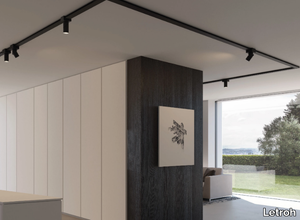
Letroh > Ceiling lamp
**NODO: A Subtle Electrical Revolution** NODO is an innovative track system that allows you to effortlessly position and adjust lighting fixtures with a simple gesture—no tools required. Designed for ultimate flexibility, it enables you to modify socket placements at any time, even after installation, eliminating the need for wall ducts or disruptive masonry work. Its ultra-flat design requires no formwork, ensuring seamless integration into any space. The system features a **Smart-ON mechanism** for quick, safe electrical connections, making installation easy without specialized training. Once in place, the intuitive **shuttle system** lets you relocate sockets, lights, and accessories on demand, reducing renovation costs and enhancing adaptability. A downloadable **3D file** of NODO is available for precise planning and integration into your projects. **Supplier Overview:** Letroh is a leading interior design supplier offering a diverse range of high-quality products for residential and commercial spaces, available globally through their website, [www.letroh.com](http://www.letroh.com).
SURFACE BOB - Ceiling/wall-mounted adjustable aluminium spotlight _ Letroh

Letroh > Ceiling lamp
**SURFACE BOB** is a versatile GU10 wall or ceiling spotlight featuring a double-joint design, enabling 90° horizontal tilt and 360° vertical rotation for precise directional lighting. Crafted from durable aluminum with an integrated heat sink, it ensures efficient thermal management while allowing easy replacement of secondary lenses. The lamp is compatible with 50mm diameter GU10 smart bulbs (such as Philips Hue, Alexa, Google Home, and Apple HomeKit), offering seamless smart lighting integration. Available in white or black finishes, it delivers high-quality illumination with options for 2700K (1100–1800 lm) or 3000K (1150–1900 lm), both at an exceptional CRI of 97. Weighing just 0.82 kg with an IP20 rating, it combines sleek design with functionality. As part of the **SURFACE** series by **Letroh**, it ensures design consistency with other lighting systems like LEVEL, NODO, and VIAVAI, making it ideal for cohesive wall, ceiling, or recessed installations. A downloadable 3D file of the product is available for detailed planning. **Letroh** is a renowned interior design supplier specializing in high-quality lighting, furniture, and decor for residential and commercial spaces, with a global presence headquartered in the US. Explore more at [www.letroh.com](http://www.letroh.com).
Nuo - LED aluminium reading lamp with swing arm _ Letroh

Letroh > Wall lamp
**SURFACE NUO** is a sleek and modern reading light designed for both functionality and aesthetic appeal. It features a 5W LED (230V, 3000K, CRI 90, 400 lm) with a glare-free diffuser, housed in an anodized aluminum structure with a flexible anthracite grey fabric-covered arm for adjustable positioning (max extension: 400 mm). Available in white or black finishes, it includes a non-dimmable integrated power supply and an ON/OFF switch, weighing just 0.50 kg (IP20, CE certified). Part of the **SURFACE** series by Letroh, it seamlessly integrates with other LETROH lighting systems like LEVEL, NODO, and VIAVAI, ensuring design coherence in wall, recessed, or ceiling installations. A downloadable 3D file of the product is available for further customization. **Letroh** is a global interior design supplier known for its stylish and functional lighting, furniture, and decor, with headquarters in the U.S. and a presence in multiple countries. Explore more at [www.letroh.com](http://www.letroh.com).
SURFACE BOB - Semi-inset aluminium spotlight _ Letroh
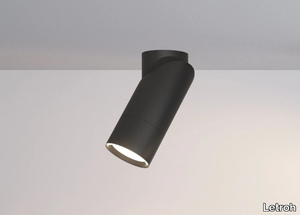
Letroh > Ceiling lamp
Here’s the rephrased and expanded product description, including a concise supplier overview and mention of the 3D file: **SURFACE BOB** is a versatile **GU10 recessed LED spotlight** featuring a **double-joint mechanism** that enables **90° horizontal tilt** and **360° vertical rotation**, offering flexible directional lighting. Crafted with a durable **aluminum structure and integrated heat sink**, it ensures efficient thermal management. The design allows for **easy replacement of secondary lenses**, enhancing customization. **Technical Specifications:** - Voltage: 230V - Socket: GU10 - Max. Power: 10W LED - Finishes: White / Black - IP Rating: 20 - Certification: CE - Weight: 0.80 kg The **compact lamp body** is tailored to accommodate **50mm-diameter GU10 bulbs** with **SMART technology compatibility** (e.g., Philips Hue, Alexa, Google Home, Apple HomeKit). As part of the **LETROH lighting family**, SURFACE BOB seamlessly integrates with other systems like **LEVEL, NODO, and VIAVAI**, ensuring design consistency for wall, ceiling, or recessed installations. **3D File Available:** A downloadable **3D model** of the product is provided for precise planning and visualization. **About the Supplier:** Letroh is a global interior design brand specializing in innovative lighting, furniture, and decor, with a focus on blending aesthetics and functionality. Explore their collection at [www.letroh.com](http://www.letroh.com). *(Note: Adjusted to balance detail with readability while highlighting key features and the 3D file.)*
SURFACE BOB - LED three-phase aluminium _ Letroh

Letroh > Ceiling lamp
Here’s the rephrased and expanded product description, including a concise supplier overview and mention of the 3D file availability: **SURFACE BOB** is a versatile three-phase LED spotlight featuring a double-joint design, enabling 90° horizontal tilt and 360° vertical rotation for precise directional lighting. Crafted from durable aluminum with an integrated heat sink, it ensures efficient thermal management while allowing easy replacement of secondary lenses. Available in white or black finishes, it complements both residential and commercial spaces with design coherence, seamlessly integrating with other **LETROH** systems like LEVEL, NODO, and VIAVAI. **Technical Specifications:** - **1 LED x 20W** (230V) - Options: **Dimmable (DALI 2)** or **Non-Dimmable** - **CRI 97** | **2700K** (1100–1800 lm) / **3000K** (1150–1900 lm) - **IP20** | **Insulation Class III** | **0.90 kg** - Requires compatible lenses (sold separately) | **Power supply included** - **3D file available for download** (contact manufacturer or visit website). **About the Supplier:** **Letroh** is a U.S.-based interior design specialist offering high-quality lighting, furniture, and decor for residential and commercial spaces, with a focus on modern aesthetics and functionality. Explore their collection at [www.letroh.com](http://www.letroh.com). *For further details on SURFACE BOB, consult Letroh’s official product documentation.*
SURFACE BOB - LED wall/ceiling aluminium spotlight _ Letroh

Letroh > Ceiling lamp
**SURFACE BOB** is a versatile wall or ceiling LED spotlight featuring a double-joint design that enables 90° horizontal tilt and 360° vertical rotation, providing flexible directional lighting. Crafted from durable aluminum with an integrated heat sink, it ensures efficient thermal management. The spotlight allows for easy replacement of secondary lenses and comes in white or black finishes. **Technical Specifications:** - 1 x 20W LED (230V) - 2700K (CRI 97, 1100–1800 lm) / 3000K (CRI 97, 1150–1900 lm) - Requires compatible lenses (sold separately) - Includes power supply - Dimmable (cut-phase) - IP20 rated, CE certified - Weight: 0.82 kg Part of the **SURFACE** collection by **Letroh**, this spotlight seamlessly integrates with the **LEVEL, NODO, and VIAVAI** systems, ensuring design consistency across wall, recessed, and ceiling installations while maintaining uniform lighting quality and finishes. A downloadable 3D file of the product is available for design planning. **Supplier Overview:** Letroh is a U.S.-based interior design supplier specializing in high-quality lighting, furniture, and decor for residential and commercial spaces, offering a blend of functionality and aesthetic appeal. Explore more at [www.letroh.com](http://www.letroh.com).
SURFACE BOB - LED semi-inset aluminium spotlight _ Letroh
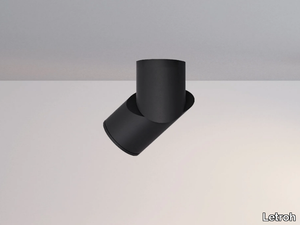
Letroh > Ceiling lamp
Here’s the rephrased and expanded product description, including a concise supplier overview and mention of the 3D file: **SURFACE BOB** is a versatile recessed LED spotlight featuring a double-joint design, enabling 90° tilt on the horizontal plane and 360° rotation around the vertical axis for precise directional lighting. Crafted from durable aluminum with an integrated heat sink, it ensures efficient thermal management, while its user-friendly design allows for easy replacement of secondary lenses. Available in white or black finishes, it complements modern interiors with a sleek, minimalist aesthetic. **Technical Specifications:** - **1 LED x 13/20W** (500 mA) - **Color Options:** - 2700K | CRI 97 | 1100–1800 lm - 3000K | CRI 97 | 1150–1900 lm - **Compatibility:** Requires separate lenses and power supply (note: power supply dimensions exceed the fixture’s hole diameter). - **Certifications:** IP20, CE, Insulation Class III - **Weight:** 0.74 kg Part of the **SURFACE** collection by Letroh, BOB seamlessly integrates with the brand’s **LEVEL, NODO, and VIAVAI** systems, ensuring design consistency across wall, ceiling, and recessed installations. A **3D file of the product is available for download**, facilitating seamless planning and integration into projects. **About the Supplier:** Letroh is a globally recognized interior design brand specializing in lighting, furniture, and decorative solutions, known for blending functionality with contemporary aesthetics. Explore their portfolio at [www.letroh.com](http://www.letroh.com). *(Note: Adjusted supplier description to one sentence while retaining key details.)*
SURFACE STUDIO - LED dimmable aluminium pendant lamp _ Letroh

Letroh > Ceiling lamp
**Product Description:** The **SURFACE STUDIO** is a sleek suspension light featuring an adjustable diffuser, designed for both functionality and modern aesthetics. It offers **ON-OFF and PWM dimming** with a **27W, 48V** power input, available in warm tones (**2700K CRI 90, 2400 lm** or **3000K CRI 90, 2550 lm**) and finishes in **white or black**. The **painted aluminum body** allows the light sources to rotate up to **90° on both sides**, enabling versatile lateral lighting. It comes in both **dark and diffused versions**, with an **adjustable cable** and **IP20 rating**, weighing just **0.89 kg**. Integrated with **PWM dimmable electronics**, it supports multiple control technologies, including **DALI, pushbutton, 100K potentiometer, and 0-10V/1-10V passive systems**. A **48V power supply (sold separately)** is required. Part of the **LETROH** lighting family, the **SURFACE STUDIO** seamlessly integrates with other systems like **LEVEL, NODO, and VIAVAI**, ensuring design consistency in wall, recessed, or ceiling installations. A **3D file of the product is available for download** for further customization and planning. **Supplier Description:** **LETROH** is a renowned interior design supplier specializing in high-quality lighting and decor for residential and commercial spaces, offering a diverse range of modern and functional products.
SURFACE STUDIO - Dimmable LED aluminium pendant lamp _ Letroh

Letroh > Ceiling lamp
**SURFACE STUDIO Suspension Light** The SURFACE STUDIO is a sleek suspension light available in both Dark and diffuser versions, designed to deliver versatile and elegant lighting solutions. Its adjustable light sources can rotate up to 90° on both sides, enabling precise lateral illumination to enhance any space. Crafted from painted aluminum, it features integrated PWM dimmable electronics compatible with various control technologies, including DALI, pushbutton, potentiometer, and 0-10V/1-10V systems. The light offers warm color temperatures (2700K or 3000K) with high CRI 90 for excellent color rendering, delivering between 2100 lm and 2250 lm. Available in white or black finishes, it requires a separate 48V power supply and comes with an adjustable cable (IP20, Class III, CE-certified, 0.89 kg). As part of the LETROH lighting family, it seamlessly integrates with other systems like LEVEL, NODO, and VIAVAI, ensuring design consistency across wall, recessed, and ceiling installations. A downloadable 3D file is available for precise planning and visualization. **Supplier:** Letroh is a leading interior design supplier specializing in high-quality lighting, furniture, and decor for residential and commercial spaces, with a global presence and a focus on innovative design solutions. Explore their collection at [www.letroh.com](http://www.letroh.com).
SURFACE STUDIO - Dimmable LED aluminium ceiling lamp _ Letroh

Letroh > Ceiling lamp
Here’s your rephrased and expanded product description, including a concise supplier overview and mention of the 3D file availability: --- The **SURFACE STUDIO** is a sleek ceiling-mounted dark light source featuring an optional diffuser, designed to deliver versatile and elegant ambient lighting. With adjustable light sources that rotate up to 90° on both sides, it enables precise lateral illumination to enhance any space. Available in **Dark** or **diffused** versions, it boasts a painted aluminum body and integrated PWM dimmable electronics, compatible with multiple control technologies (DALI, pushbutton, potentiometer, 0-10V, and 1-10V). Technical specifications include **9W/18W power (48V)**, **2700K/3000K color temperatures (CRI 90)**, and outputs of **700-1500 lm**, with finishes in **white or black**. A separate **48V power supply** is required (IP20, Class III, CE-certified). This fixture seamlessly integrates with **LETROH’s** lighting systems (LEVEL, NODO, VIAVAI), ensuring design consistency across wall, recessed, and ceiling installations. A downloadable **3D file** is available for precise planning and visualization. *LETROH is a globally recognized interior design supplier specializing in high-quality lighting, furniture, and decor for residential and commercial spaces, with headquarters in the U.S. and a strong international presence.* --- Let me know if you'd like any further refinements!
SURFACE STUDIO - LED dimmable aluminium ceiling lamp _ Letroh

Letroh > Ceiling lamp
Here’s a refined and expanded product description, including a concise supplier overview and mention of the 3D file availability: **SURFACE STUDIO** is a versatile ceiling light featuring a sleek diffuser, designed to deliver both functional and ambient illumination. Its adjustable design allows the light sources to rotate up to 90° on either side, enabling flexible lateral lighting to suit any environment. Available in two versions—Dark or with a diffuser—the fixture boasts a painted aluminum body and integrates PWM dimmable electronics, compatible with multiple control technologies (DALI, pushbutton, 100K potentiometer, 0-10V, or 1-10V). Technical specifications include 9W/18W power (48V required, sold separately), 2700K or 3000K color temperatures (CRI 90), and outputs of 800–1700 lm, with finishes in white or black. Insulation class III and IP20 rated, it weighs 0.48–0.69 kg. Part of the **SURFACE** series, it complements LETROH’s lighting systems (LEVEL, NODO, VIAVAI) with design consistency for wall, recessed, or ceiling installations. A downloadable 3D file is available for seamless integration into project planning. **Supplier Overview**: LETROH is a global interior design brand (headquartered in the U.S.) offering curated lighting, furniture, and decor for residential and commercial spaces, blending innovation with timeless aesthetics. Explore more at [www.letroh.com](http://www.letroh.com).
SURFACE MINI - Semi-inset LED aluminium spotlight _ Letroh

Letroh > Ceiling lamp
Here’s the rephrased and expanded product description, including a concise supplier overview and mention of the 3D file availability: **SURFACE MINI** is a sleek, recessed dark light source designed for seamless integration into walls and ceilings, combining minimalist aesthetics with high-performance lighting. Its ultra-compact design features a painted aluminum structure with an integrated heat sink, ensuring durability and efficient heat dissipation. The light source delivers exceptional quality with 9W output (250 mA), available in 2700K (698 lm) or 3000K (740 lm), both boasting a CRI of 97 for vibrant, true-to-life illumination. The fixture includes a 20° lens and honeycomb for precise light control and comes in white or black finishes. Note: A separate power supply is required (ensure compatibility, as the hole diameter is smaller than standard power supplies). With an IP20 rating, Class III insulation, and CE certification, it weighs just 0.17 kg. Part of the **SURFACE** range, it complements LETROH’s **LEVEL, NODO, and VIAVAI** systems, sharing the same light sources for design consistency across installations. A downloadable 3D file is available for precise planning. For more details, visit the manufacturer’s website. **Supplier Overview**: Letroh is a U.S.-based interior design specialist offering high-quality lighting, furniture, and decor for residential and commercial spaces, with a global presence. Explore their collection at [www.letroh.com](http://www.letroh.com).
SURFACE MINI - Round ceiling LED aluminium spotlight _ Letroh
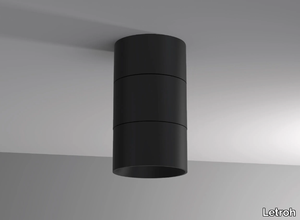
Letroh > Ceiling lamp
Here’s the rephrased and expanded product description, including a concise supplier overview and mention of the 3D file availability: --- The **SURFACE MINI** is a sleek, ceiling-mounted dark light source designed for seamless integration into modern interiors. This ultra-compact spotlight features a painted aluminum structure with an integrated heat sink, ensuring both durability and efficient performance. It offers easy replacement of secondary optics, with a 20° lens and honeycomb grid included for tailored lighting effects. Available in white or black finishes, the SURFACE MINI delivers high-quality illumination with options for 2700K (698 lm) or 3000K (740 lm), both at an exceptional CRI 97. Compatible with LEVEL, NODO, and VIAVAI systems, it maintains design coherence across wall, recessed, and ceiling installations. Requires a separate power supply (Class III, IP20, CE-certified) and weighs just 0.17 kg. A downloadable 3D file is available for precise planning. **Supplier Overview:** Letroh is a renowned interior design supplier specializing in lighting, furniture, and decor for residential and commercial spaces, with a global presence headquartered in the U.S. For technical details, visit the manufacturer’s website: [www.letroh.com](http://www.letroh.com). --- Let me know if you'd like any further refinements!
SURFACE MINI - Adjustable ceiling LED aluminium spotlight _ Letroh

Letroh > Ceiling lamp
Here’s the rephrased and expanded product description, including a concise supplier overview and mention of the 3D file availability: **SURFACE MINI** is an adjustable ceiling dark light source designed for seamless integration into modern interiors. Its ultra-compact design features a painted aluminum structure with an efficient heat sink, allowing for easy replacement of secondary optics like the included 20° lens and honeycomb. Technical specifications include a 9W (250 mA) LED with high CRI 97, offering 698 lm (2700K) or 740 lm (3000K), available in white or black finishes. The product requires an external power supply (not included), adheres to insulation class III and IP20 standards, and weighs just 0.16 kg. Part of the **SURFACE** range, it complements **LETROH**’s lighting systems (LEVEL, NODO, VIAVAI) by sharing compatible light sources, ensuring design coherence in wall, recessed, or ceiling installations. A downloadable 3D file of the product is available for precise planning. For more details, visit the manufacturer’s website. **Supplier Overview**: Letroh is a U.S.-based interior design supplier specializing in lighting, furniture, and decor for residential and commercial spaces, with a global presence. (Note: The supplier description is condensed to one sentence as requested, while the product details are expanded and restructured for clarity.)
Recently Viewed Products
A wide range of product from furniture to finishes to meet the desire of all designers.
JACK-E INTRECCIO - Wooden double bed _ Bolzan
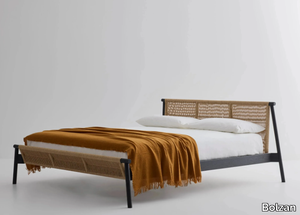
Bolzan > Bed frame
The **Jack-e Intreccio** bed features a minimalist ash wood structure, elevated by a striking headboard and footboard woven from brown paper ropes—their intricate interplay of solids and voids creates a captivating, semi-transparent pattern. This design reflects the **Jack-e collection's** evolution, embodying Bolzan’s commitment to sustainable craftsmanship, local heritage, and timeless beauty. The bed is available in **Terra di Siena, Nero Vite, and Verde Ginepro** finishes, with a downloadable 3D file for design planning. **Bolzan**, a renowned Italian design house since 1976, crafts premium furniture and lighting, blending contemporary elegance with artisanal precision. (Note: The supplier description is condensed to one sentence as requested, while the product description is expanded and the 3D file detail is added.)
BUTLER - LED metal floor lamp with shelf _ Linea Light Group
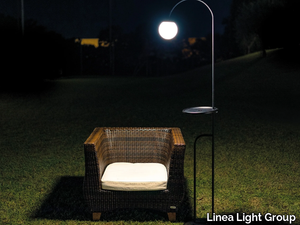
Linea Light Group > Floor lamp
Here’s a refined and expanded product description with a concise supplier overview, including the 3D file availability: **Product Description:** The *Butler* is a versatile floor lamp, aptly named the "lamp-butler" for its dual functionality—featuring a practical accessory support tray and a convenient bag hook. Ideal for illuminating conversation areas, it enhances both sheltered spaces like gazebos and open-air settings. Crafted from black painted metal with a spherical diffuser in white linear polyethylene, it combines durability with elegant simplicity. The lamp’s special cataphoresis treatment ensures long-lasting anti-corrosive protection. It operates with a topLED 7W DC / 8W AC 350mA light source (220-240V) for efficient, high-quality illumination. A 3D file of the product is available for download, facilitating seamless integration into design projects. **Supplier Overview:** Linea Light Group, a renowned Italian lighting innovator since 1985, specializes in high-end interior and architectural lighting solutions, blending cutting-edge technology with sleek, contemporary designs. For more details, visit [www.linealight.com](http://www.linealight.com).
VIAVAI LED BOARD - LED strip light _ Letroh

Letroh > Lighting accessories
**VIAVAI LED BOARD** is a sleek, linear LED module designed for seamless integration into mono or double-emission tracks, offering a continuous line of light with dimmable ON-OFF functionality. Built on an FR-4 PCB support, it features power and signal pickup contacts with a spring pusher for easy installation. Available in multiple wattages (9W, 13W, 17W) and color temperatures (2700K, 3000K), it delivers high-quality illumination with a CRI of 95 and IP20 insulation. The system is part of the innovative **VIAVAI 48V linear lighting range**, combining low-voltage track functionality with architectural lighting versatility—suitable for direct, indirect, wall-mounted, suspended, or recessed installation. Its slim profile, copper conductors in heat-resistant insulation (glow wire 850°C), and modular design (cuttable to size) ensure adaptability for any space. Choose from three variants: **MONO** (direct/suspended/recessed), **DUO W** (wall-mounted), or **DUO S** (suspended), in black or white epoxy finishes. A 3D file of the product is available for download to assist with planning and integration. **Supplier Insight:** Letroh is a U.S.-based interior design supplier (www.letroh.com) specializing in lighting, furniture, and decor for residential and commercial spaces, offering globally accessible, style-diverse solutions. *Key Features:* - Dimmable, high-CRI (95) LEDs - 108 LEDs/56cm, 48V operation - Lumen outputs: 1080lm–2088lm (varies by model) - Class III insulation, CE-certified - Snap-system installation, multi-point power delivery - Compatible with closing profiles, joints, and power supplies - Max capacity: 10A
Products From the Same Collection
A wide range of product from furniture to finishes to meet the desire of all designers.
VIAVAI BOB - Adjustable light source for aluminium track-Light _ Letroh

Letroh > Ceiling lamp
**VIAVAI BOB** is a versatile, adjustable LED spotlight featuring a double-joint design that enables 90° horizontal tilt and 360° vertical rotation, providing flexible lighting control. Crafted with a durable aluminum structure and integrated heat sink, it ensures efficient performance and longevity. The light source allows easy replacement of secondary lenses, with optics options including 30°, 40°, 60°, oval, rectangular, and Wallwasher, along with warm shade LEDs (2700K and 3000K, CRI 97). Compatible with multiple control systems (ON-OFF, 0-10V, DALI, DALI 2, CASAMBI), it offers dimmable functionality in select versions. The sleek design comes in white or black finishes, includes an adjustable cable, and meets IP20 and Class III safety standards (0.80 kg). A 3D file of the product is available for download, facilitating seamless integration into design plans. **Supplier Description:** Letroh is a leading interior design supplier specializing in high-quality lighting, furniture, and decor for residential and commercial spaces, with a global presence and a focus on innovative solutions. VIAVAI is part of a 48V linear lighting system, combining low-voltage track functionality with sleek linear profiles for architectural lighting. Ideal for direct or indirect illumination, it supports wall, ceiling, suspended, or recessed installation via multiple fixing systems. The modular design includes snap-in LED sources, copper conductors in fire-resistant insulation (glow wire 850°C), and customizable track lengths (cut-to-size by professionals). Available in MONO (direct/suspended/recessed), DUO W (wall-mounted), and DUO S (suspended) variants, it features a slim profile, black/white finishes, and supports up to 10A capacity. Additional components include closing profiles, joints, power supplies, and terminals for a polished finish.
VIAVAI ZOOM - Suspension for aluminium track-Light _ Letroh

Letroh > Ceiling lamp
**Product Description:** The **VIAVAI ZOOM** is a versatile suspension light source designed for architectural lighting, featuring an innovative snap-fastening system that allows effortless movement and addition of light sources. With adjustable optics ranging from 12 to 46 degrees, it ensures optimal light distribution for various settings. The sleek, painted aluminum body houses integrated electronics, available in multiple configurations: **ON-OFF, "ONE BY ONE" dimmable, 0-10V dimmable, and DALI dimmable**. **Technical Features:** - **ON-OFF Version:** 1 x 13W - 48V - **ONE BY ONE Dimmable:** 1 x 13W - 48V - **0-10V Dimmable:** 1 x 13W - 48V - **Color Options:** 2700K (CRI 97, 831/1010 lm) or 3000K (CRI 97, 878/1068 lm) - **Finishes:** White or Black - **Adjustable Optic:** 12°–46° - **Converter Included** - **Adjustable Cable** - **Insulation Class III, IP20** - **Weight:** 0.42 kg Part of the **VIAVAI** 48V linear lighting system, this product combines the flexibility of low-voltage tracks with the sleek design of linear profiles, suitable for direct, indirect, suspended, or recessed installation. The system features copper conductors in an insulated profile, supports multiple configurations (MONO, DUO W, DUO S), and can be cut to size by a qualified technician. A **3D file of the product is available for download**, facilitating seamless integration into design plans. **Supplier Description:** Letroh is a U.S.-based interior design supplier offering a curated selection of lighting, furniture, and decor for residential and commercial spaces, available globally through their website, [www.letroh.com](http://www.letroh.com).
VIAVAI ZOOM - Fixed source for aluminium track-Light _ Letroh

Letroh > Ceiling lamp
**Product Description:** The **VIAVAI ZOOM** is a versatile fixed light source designed for seamless integration into the **VIAVAI 48V linear lighting system**. Featuring an innovative snap-fastening mechanism, the ZOOM light sources can be effortlessly moved, repositioned, or added along the track for customizable illumination. Its adjustable optics (12° to 46°) allow precise control over the light beam, ensuring optimal adaptation for various lighting effects. The sleek, painted aluminum body houses high-performance LED modules, available in multiple dimming options—**ON-OFF, 0-10V, DALI, and "ONE BY ONE"**—providing flexibility for different lighting control systems. With a **CRI of 97** and warm color temperatures (**2700K or 3000K**), it delivers exceptional light quality (up to **1068 lm**). The **IP20-rated** fixture includes an integrated converter and comes in **white or black finishes**, making it ideal for both residential and commercial architectural lighting. For added convenience, a **3D file of the product is available for download**, facilitating seamless integration into design plans. **Supplier Description:** Letroh is a leading interior design supplier specializing in high-quality lighting, furniture, and decor for both residential and commercial spaces, with a strong global presence. The **VIAVAI system** is a groundbreaking **48V low-voltage lighting solution**, combining the flexibility of track lighting with the sleek aesthetics of linear profiles. Designed for **direct, indirect, suspended, or recessed installation**, it supports multiple configurations (**MONO, DUO W, DUO S**) to suit diverse architectural needs. Its **ultra-slim profile**, **glow-wire insulated copper conductors (850°C rated)**, and modular design allow for easy customization, including on-site cutting by professionals. With **10A max capacity** and **CE certification**, VIAVAI ensures both performance and safety, making it a top choice for modern lighting design.
VIAVAI ZOOM - Adjustable source for aluminium track-Light _ Letroh

Letroh > Ceiling lamp
**VIAVAI ZOOM** is a versatile, adjustable light source designed for architectural lighting, featuring a user-friendly snap-fastening system that allows effortless movement and addition of light modules. Its adjustable optics (12° to 46°) provide optimal light beam control, while the painted aluminum body ensures durability. Available in multiple dimming options—ON/OFF, 0-10V, and DALI—it delivers high-quality illumination with 2700K (CRI 97, 831/1010 lm) and 3000K (CRI 97, 878/1068 lm) options in white or black finishes. The integrated 48V system includes a converter, adheres to IP20 and Class III standards, and weighs just 0.33 kg. Part of the **VIAVAI** line, it combines low-voltage track functionality with sleek linear profiles, suitable for direct, indirect, wall-mounted, suspended, or recessed installation. A 3D file of the product is available for download, aiding in seamless integration into design plans. **Supplier:** Letroh is a global interior design supplier known for its diverse range of high-quality lighting, furniture, and decor, available at various price points to suit different project needs. Explore their offerings at [www.letroh.com](http://www.letroh.com).
VIAVAI MINI - Suspension for aluminium track-Light _ Letroh

Letroh > Ceiling lamp
**Product Description:** The **VIVAI MINI** is a sleek and versatile suspension light source designed for flexibility and ease of use. Its compact design allows for effortless movement and customization, thanks to an intuitive snap-fastening system. The light features a painted aluminum body and offers easy replacement of secondary optics. Available in multiple dimming options—including "ONE BY ONE," ON-OFF, 0-10V dimmable, and DALI dimmable versions—it provides adaptable lighting solutions for various settings. **Technical Specifications:** - **Power:** 1 x 9W - 48V - **Color Temperatures:** 2700K (CRI 97, 728 lm) / 3000K (CRI 97, 770 lm) - **Finishes:** White or Black - **Includes:** Lenses, converter, adjustable cave - **Certifications:** IP20, CE, Insulation Class III - **Weight:** 0.23 kg The **VIAVAI** system, to which the MINI belongs, is a cutting-edge 48V linear lighting solution that merges the functionality of low-voltage tracks with the elegance of architectural lighting. It supports direct, indirect, suspended, or recessed installation, with multiple fixing options for seamless integration. The system features copper conductors in an insulated profile, supports customizable lengths, and comes in MONO, DUO W, and DUO S variants for diverse applications. A **3D file of the product is available for download**, facilitating easy planning and integration into design projects. **Supplier Description:** Letroh is a leading interior design supplier specializing in high-quality lighting, furniture, and decor for both residential and commercial spaces, with a strong global presence.
VIAVAI MINI - Fixed light source for aluminium track-Light _ Letroh

Letroh > Ceiling lamp
**Product Description:** The **VIVAI MINI** is a sleek, fixed light source featuring a diffuser, designed for effortless flexibility with its compact, snap-fastening system that allows easy movement and addition of modules. The secondary optics are simple to replace, and its durable painted aluminum body ensures longevity. Available in multiple integrated electronic configurations—**ON-OFF, "ONE BY ONE" dimmable, 0-10V dimmable, and DALI dimmable**—it offers versatile lighting control. **Technical Features:** - **ON-OFF Version:** 1 x 9W - 48V - **ONE BY ONE Dimmable:** 1 x 9W - 48V - **0-10V Dimmable:** 1 x 9W - 48V - **Color Options:** 2700K (CRI 97, 728 lm) / 3000K (CRI 97, 770 lm) - **Finishes:** White or Black - **Includes:** Lenses (to be completed), converter - **Insulation Class:** III / IP20 - **Weight:** 0.11 kg Part of the **VIAVAI** 48V linear lighting system, the **VIVAI MINI** combines the adaptability of low-voltage tracks with the sleekness of linear profiles, ideal for both direct and indirect architectural lighting. The system supports multiple installation methods—wall-mounted, suspended, or recessed—and features copper conductors in a high-temperature-resistant insulating profile. With customizable lengths and a minimalist design, **VIAVAI** ensures seamless integration into any space. A **3D file of the product is available for download**, facilitating easy planning and integration into design projects. **Supplier Description:** Letroh is a U.S.-based interior design supplier known for its diverse range of high-quality lighting, furniture, and décor for residential and commercial spaces, available globally through their website, [www.letroh.com](http://www.letroh.com).
VIAVAI MINI - Suspension for aluminium track-Light _ Letroh

Letroh > Ceiling lamp
**Product Description:** The **VIVAI MINI** is a sleek, suspension-mounted dark light source designed for flexibility and ease of use. Compact and modular, these fixtures can be effortlessly repositioned or expanded thanks to an intuitive snap-fastening system. The secondary optics are easily replaceable, allowing for customization, while the durable painted aluminum body ensures longevity. Available in multiple integrated electronic configurations—including ON/OFF, 0-10V dimmable, and DALI dimmable versions—the VIVAI MINI adapts to various lighting needs. **Technical Features:** - **ON-OFF Version:** 1 x 9W - 48V - **ONE BY ONE Dimmable:** 1 x 9W - 48V - **0-10V Dimmable:** 1 x 9W - 48V - **Color Options:** 2700K (CRI 97, 698 lm) or 3000K (CRI 97, 740 lm) - **Finishes:** White or Black - **Included Accessories:** 20° lens, honeycomb diffuser, converter - **Adjustable cave for precise light direction** - **Insulation Class III, IP20, CE Certified** - **Weight:** 0.25 kg Part of the **VIAVAI** 48V linear lighting system, the MINI integrates seamlessly into this innovative architectural lighting solution, which combines the adaptability of low-voltage tracks with the elegance of linear profiles. The system supports direct, indirect, suspended, or recessed installation, with multiple mounting options and copper conductors embedded in high-temperature-resistant insulation. A 3D file of the product is available for download, facilitating seamless integration into design plans. **Supplier Description:** Letroh is a leading interior design supplier offering high-quality lighting, furniture, and decor for residential and commercial spaces, with a global presence headquartered in the US. Explore their collection at [www.letroh.com](http://www.letroh.com).
VIAVAI MINI - Suspension for aluminium track-Light _ Letroh

Letroh > Ceiling lamp
**Product Description:** The **VIVAI MINI** is a sleek, suspended dark light source designed for flexibility and ease of use. Its compact design allows for effortless movement and positioning, thanks to an intuitive snap-fastening system. The fixture features a painted aluminum body and offers easy replacement of secondary optics for customizable lighting. Available in multiple dimming options—**ON-OFF, 0-10V dimmable, and DALI dimmable**—it provides versatile control for any setting. Technical specifications include a **9W - 48V LED** with high CRI (97) in **2700K (698 lm) or 3000K (740 lm)**, ensuring excellent color rendering. Finishes come in **white or black**, and the product includes an adjustable cave, converter, and optional lenses for tailored illumination. With an **IP20 rating and Class III insulation**, it’s both safe and durable. A **3D file of the product is available for download**, aiding in seamless integration into design plans. **Supplier Description:** Letroh is a trusted interior design supplier specializing in high-quality lighting, furniture, and decor for residential and commercial spaces, with a global presence and a focus on innovative solutions. **Additional Product Details:** Part of the **VIAVAI 48V linear lighting system**, the VIVAI MINI combines the adaptability of low-voltage tracks with the sleekness of linear profiles, ideal for both direct and indirect lighting. The system supports multiple installation methods—wall-mounted, suspended, or recessed—and features copper conductors in a fire-resistant insulating profile (glow wire 850°C). With **MONO, DUO W, and DUO S variants**, it accommodates diverse layouts and can be cut to size by professionals. The minimalist design, available in **black or white**, ensures seamless integration into modern interiors while maximizing functionality.
VIAVAI MINI - Fixed light source for aluminium track-Light _ Letroh

Letroh > Ceiling lamp
**Product Description:** The **VIVAI MINI** is a compact, fixed dark light source designed for effortless flexibility, featuring a snap-fastening system that allows easy movement and addition of modules. Its secondary optics can be quickly replaced, and the sleek painted aluminum body houses integrated electronics available in multiple versions: **ON-OFF, "ONE BY ONE" dimmable, 0-10V dimmable, and DALI dimmable**. **Technical Features:** - **Power & Voltage:** 1 x 9W - 48V - **Color Options:** 2700K (CRI 97, 698 lm) or 3000K (CRI 97, 740 lm) - **Finishes:** White or Black - **Included Accessories:** 20° lens, honeycomb diffuser, and converter - **Certifications:** IP20, CE-rated - **Weight:** 0.14 kg Part of the **VIAVAI 48V linear lighting system**, the MINI combines the adaptability of low-voltage tracks with the sleekness of linear profiles, ideal for both direct and indirect ambient lighting. The system supports wall, ceiling, suspended, or recessed installation with multiple fixing options and includes copper conductors in high-temperature-resistant insulation (glow wire 850°C). Customizable with closing profiles, joints, and power supplies, VIAVAI can be cut to size and is available in **MONO, DUO W (wall-mounted), and DUO S (suspended)** variants, all in black or white finishes. **3D File Available:** A downloadable 3D model of the product is provided for precise planning and integration into design projects. **Supplier Description:** Letroh is a global interior design supplier known for its diverse range of high-quality lighting, furniture, and decor, blending innovation with functionality. (Learn more: [www.letroh.com](http://www.letroh.com))
VIAVAI MINI - Fixed light source for aluminium track-Light _ Letroh

Letroh > Ceiling lamp
**VIVAI MINI** is a compact, fixed light source designed for effortless flexibility, featuring a snap-fastening system that allows for easy movement and addition of modules. Its aluminum body comes in white or black finishes, with replaceable secondary optics for customizable lighting. The integrated electronics offer multiple control options, including ON-OFF, 0-10V dimming, and DALI dimming, with a 9W - 48V power supply. Available in 2700K (CRI 97, 728 lm) or 3000K (CRI 97, 770 lm), it includes lenses and a converter, meeting IP20 and Class III safety standards. A downloadable 3D file of the product is available for design integration. **Supplier:** Letroh is a leading interior design supplier offering innovative lighting solutions, including the VIVAI line, known for its cutting-edge architectural lighting systems. Explore their products at [www.letroh.com](http://www.letroh.com). Part of the **VIAVAI** 48V linear lighting system, the MINI integrates seamlessly into tracks designed for direct, indirect, suspended, or recessed installation. The system features copper conductors in an insulated profile, supports multiple configurations (MONO, DUO W, DUO S), and allows for custom cuts by qualified technicians. With a sleek, low-profile design and versatile mounting options, VIAVAI combines functionality with aesthetic precision, available in black or white epoxy finishes.
VIAVAI MINI - Adjustable light source for aluminium track-Light _ Letroh

Letroh > Ceiling lamp
**Product Description:** The **VIVAI MINI** is a compact and adjustable dark light source designed for seamless integration and flexibility in architectural lighting. Featuring a snap-fastening system, it allows for effortless movement and addition of light sources, while secondary optics can be easily replaced. The durable painted aluminum body houses integrated electronics, available in multiple versions: **ON-OFF, 0-10V dimmable, and DALI dimmable**. With a high CRI of 97, it delivers excellent light quality (2700K – 698 lm / 3000K – 740 lm) and includes a 20° lens and honeycomb for precise beam control. The **Class III IP20-rated** fixture comes in white or black finishes and includes a converter, weighing just 0.14 kg. A **3D file of the product is available for download**, facilitating easy integration into design plans. Part of the **VIAVAI 48V linear lighting system**, the VIVAI MINI combines the adaptability of low-voltage tracks with the sleek functionality of linear profiles. Ideal for both direct and indirect lighting, it supports multiple installation methods—wall-mounted, suspended, or recessed—with an innovative snap-in mechanism for effortless light source placement. The system features copper conductors in high-temperature-resistant insulation, customizable cutting, and multiple closing profiles for a clean aesthetic. Available in **MONO, DUO W (wall), and DUO S (suspended)** variants, it maximizes versatility with a slim profile and 10A capacity. **Supplier Description:** Letroh is a U.S.-based interior design supplier known for its high-quality lighting, furniture, and decor, catering to both residential and commercial spaces. For more details, visit [www.letroh.com](http://www.letroh.com).
VIAVAI MINI - LED aluminium track-Light _ Letroh

Letroh > Ceiling lamp
**VIVAI MINI Wall Light** The **VIVAI MINI** is a sleek and versatile wall-mounted light source, designed for flexibility and ease of use. Its compact size allows for effortless repositioning and addition thanks to an intuitive snap-fastening system, while the secondary optics can be quickly replaced as needed. Crafted from durable painted aluminum, it features integrated electronics with multiple control options, including **ON-OFF, 0-10V dimmable, and DALI dimmable** versions. **Technical Specifications:** - **Power:** 1 x 9W - 48V - **Color Temperatures:** 2700K (CRI 97, 728 lm) / 3000K (CRI 97, 770 lm) - **Finishes:** White or Black - **Insulation Class:** III / IP20 - **Weight:** 0.30 kg Part of the **VIAVAI** 48V linear lighting system, the MINI combines the adaptability of low-voltage tracks with the sleek aesthetics of modern architectural lighting. The system supports various installation methods—wall-mounted, suspended, or recessed—and includes copper conductors in a high-temperature-resistant insulating profile. A **3D file of the product is available for download**, facilitating seamless integration into design plans. **Supplier Overview:** Letroh is a leading interior design supplier offering high-quality lighting, furniture, and décor for residential and commercial spaces, with a global presence and a focus on innovative solutions. Explore their collection at [www.letroh.com](http://www.letroh.com).
VIAVAI MINI - Adjustable light source for aluminium track-Light _ Letroh

Letroh > Ceiling lamp
**Product Description:** The **VIVAI MINI** is a versatile, adjustable light source designed for flexibility and ease of use. Its compact design allows for effortless movement and positioning, thanks to a convenient snap-fastening system. The secondary optics can be easily replaced, and the durable painted aluminum body ensures longevity. Available in multiple configurations—including **ON-OFF, 0-10V dimmable, and DALI dimmable versions**—it offers seamless integration into various lighting setups. **Technical Features:** - **Power:** 1 x 9W - 48V - **Color Temperatures:** 2700K (CRI 97, 728 lm) / 3000K (CRI 97, 770 lm) - **Finishes:** White or Black - **Includes lenses and converter** - **Insulation Class III, IP20, CE certified** - **Weight:** 0.12 kg Part of the **VIAVAI 48V linear lighting system**, the VIVAI MINI combines the adaptability of low-voltage tracks with the sleekness of linear profiles, making it ideal for both direct and indirect lighting in residential and commercial spaces. The system supports multiple installation methods—wall-mounted, suspended, or recessed—and features copper conductors in a high-temperature-resistant insulating profile. A **3D file of the product is available for download**, allowing for precise planning and integration into design projects. **Supplier Description:** Letroh is a leading interior design supplier offering high-quality lighting, furniture, and decor for home and commercial spaces, with a global presence and a focus on innovative solutions. Explore their collection at [www.letroh.com](http://www.letroh.com).
VIAVAI LED BOARD - LED strip light _ Letroh

Letroh > Lighting accessories
**VIAVAI LED BOARD** is a sleek, linear LED module designed for seamless integration into mono or double-emission tracks, offering a continuous line of light with dimmable ON-OFF functionality. Built on an FR-4 PCB support, it features power and signal pickup contacts with a spring pusher for easy installation. Available in multiple wattages (9W, 13W, 17W) and color temperatures (2700K, 3000K), it delivers high-quality illumination with a CRI of 95 and IP20 insulation. The system is part of the innovative **VIAVAI 48V linear lighting range**, combining low-voltage track functionality with architectural lighting versatility—suitable for direct, indirect, wall-mounted, suspended, or recessed installation. Its slim profile, copper conductors in heat-resistant insulation (glow wire 850°C), and modular design (cuttable to size) ensure adaptability for any space. Choose from three variants: **MONO** (direct/suspended/recessed), **DUO W** (wall-mounted), or **DUO S** (suspended), in black or white epoxy finishes. A 3D file of the product is available for download to assist with planning and integration. **Supplier Insight:** Letroh is a U.S.-based interior design supplier (www.letroh.com) specializing in lighting, furniture, and decor for residential and commercial spaces, offering globally accessible, style-diverse solutions. *Key Features:* - Dimmable, high-CRI (95) LEDs - 108 LEDs/56cm, 48V operation - Lumen outputs: 1080lm–2088lm (varies by model) - Class III insulation, CE-certified - Snap-system installation, multi-point power delivery - Compatible with closing profiles, joints, and power supplies - Max capacity: 10A
VIAVAI LED BOARD - LED strip light _ Letroh

Letroh > Lighting accessories
**VIAVAI LED BOARD** is a sleek, curved LED board module featuring dimmable ON-OFF functionality, perfect for creating seamless lines of light in single or double-emission tracks. Crafted with an FR-4 PCB support, it includes power and signal pickup contacts with a spring pusher for easy installation. The board is available in multiple configurations, offering high CRI 95 lighting with varying wattages (12W, 16W, 24W) and color temperatures (2700K, 3000K) to suit different ambiance needs. With IP20 insulation, CE certification, and a lightweight design (0.20 kg), it ensures both performance and safety. Part of the innovative **VIAVAI 48V linear lighting system**, this product combines low-voltage track functionality with architectural lighting versatility, ideal for direct, indirect, wall-mounted, suspended, or recessed installations. The system features copper conductors in a high-temperature-resistant insulating profile (glow wire 850°C), snap-in LED sources, and customizable track lengths (cuttable by professionals). Available in **MONO**, **DUO W**, and **DUO S** variants with black or white epoxy finishes, it maximizes aesthetic flexibility while maintaining a slim profile. A downloadable **3D file** of the product is available for design integration. **Supplier:** Letroh is a global interior design supplier specializing in modern lighting, furniture, and decor, offering high-quality solutions for residential and commercial spaces. Explore their collection at [www.letroh.com](http://www.letroh.com).
VIAVAI DUO - Extruded aluminium track-Light system _ Letroh

Letroh > Accessories
Here’s your rephrased and expanded product description, including a concise supplier overview and mention of the 3D file availability: --- The **VIAVAI DUO track** is crafted from extruded aluminum with a durable epoxy paint finish, available in sleek black or white, and can be custom-cut to fit any space. Designed for versatility, it offers both wall-mounted and suspended installation options, supporting a maximum capacity of 10A per line. As part of the innovative **VIAVAI 48V linear lighting system**, it combines the efficiency of low-voltage tracks with the seamless integration of linear profiles, making it ideal for direct or indirect ambient lighting. The system features an intuitive snap-in mechanism for effortless installation of LED sources, which can be powered at any point along the track. With multiple mounting options—including direct ceiling or wall attachment, suspension, or recessed installation—VIAVAI DUO adapts to diverse design needs. The track includes copper conductors housed in high-temperature-resistant insulation (glow wire 850°C), along with optional closing profiles, joints, and power supplies for a polished finish. A **3D file of the product is available for download**, enabling precise planning and integration into projects. **Supplier Overview**: Letroh is a U.S.-based interior design supplier known for its curated selection of lighting, furniture, and decor, catering to both residential and commercial spaces. Available in three variants—**MONO** (direct, suspended, or recessed), **DUO W** (wall-mounted), and **DUO S** (suspended)—VIAVAI blends cutting-edge technology with a minimalist profile for unmatched versatility and aesthetic appeal. For detailed specifications, visit the manufacturer’s page on **VIAVAI DUO by Letroh**. --- This version keeps the technical details intact while improving flow, adding the 3D file note, and condensing the supplier info to one sentence. Let me know if you'd like any further refinements!
VIAVAI MONO - Extruded aluminium track-Light system _ Letroh

Letroh > Accessories
Here’s a refined and expanded product description, including a brief supplier overview and mention of the 3D file availability: **Product Description:** The **VIAVAI MONO track** is crafted from high-quality extruded aluminum, featuring a sleek epoxy paint finish in black or white, designed to blend seamlessly into modern interiors. Its versatile design allows for direct wall or ceiling mounting, suspension, or recessed installation, supported by four distinct fixing systems for flexible placement. With a maximum capacity of 10A, this 48V linear lighting system merges the functionality of low-voltage tracks with the elegance of architectural lighting profiles. The innovative snap-system ensures effortless installation of LED light sources, while copper conductors housed in heat-resistant insulation (glow wire 850°C) guarantee safety and durability. Customizable with closing profiles, joints, and power supplies, VIAVAI MONO can be cut to size by a professional for tailored solutions. Available in three variants—**MONO** (direct/suspended/recessed), **DUO W** (wall-mounted), and **DUO S** (suspended)—this system excels in both direct and indirect lighting applications. For added convenience, a **3D file of the product is available for download**, enabling precise planning and integration into your design projects. **Supplier Overview:** Letroh is a globally recognized interior design supplier, headquartered in the U.S., offering innovative lighting solutions like VIAVAI alongside furniture and decor for residential and commercial spaces. *(Note: Adjusted to one sentence as requested.)*
Recommended Products
A wide range of product from furniture to finishes to meet the desire of all designers.
AIM MULTIPLE ROSE - Aluminium lamp holder _ Flos
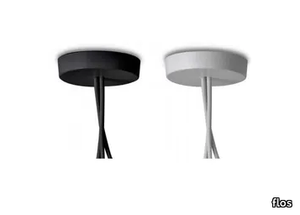
flos > Lighting accessories
The Multiple Rose by Flos is a versatile lighting solution that allows you to install between two to five Aim or Aim Small lamps, offering flexibility in design and illumination. Available in both white (F0093009) and black (F0093030) finishes, this product is perfect for creating a customized lighting arrangement in residential or commercial spaces. A 3D file of the product is also available for download, enabling you to visualize and plan your setup with precision. Flos, an iconic Italian lighting brand established in 1962, is renowned for its innovative, high-quality designs that blend cutting-edge technology with timeless aesthetics, making it a trusted choice for premium lighting solutions worldwide.
CONTINUOUS ROD MINIMAL - Aluminium linear lighting profile _ SIMES
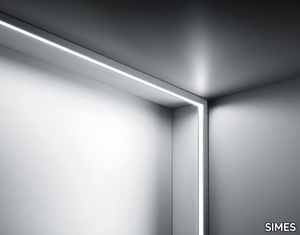
SIMES > Lighting accessories
The Continuous Rod Minimal is a sleek, linear luminaire featuring a high-performance IP65-rated LED strip encased within a slim aluminum profile, available in both surface-mounted and recessed versions. Designed for versatility, it includes optional accessories that expand its applications, such as straight connectors for seamless, continuous installations and angular accessories for creating 90° angles on single or perpendicular surfaces. A specialized recessed box allows for installation in brick or concrete walls, while 24V remote dimmable power supplies enable adjustable light intensity. Additionally, a downloadable 3D file of the product is available for precise planning and integration. Manufactured by SIMES, a renowned Italian interior design supplier established in 1973, the company is globally recognized for its innovative, high-quality lighting solutions and extensive product range tailored to modern, contemporary, and traditional design preferences.
ASAI SIDE BEND - Polyurethane linear lighting profile for LED modules _ LedsC4

LedsC4 > Lighting accessories
**Product Description:** The **Asai Side Bend** is a sleek, linear lighting profile made from durable **polyurethane**, designed for **LED modules** and suitable for both **indoor and outdoor** applications. Available in multiple variants, it offers versatile lighting with **color temperatures** of **3000K, 4000K, and RGB**, a **CRI of 80**, and a **wattage range of 14.4W to 115.2W**, delivering **194 to 3988 lumens** for optimal brightness and **visual comfort (UGR 20-20.4)**. Part of the innovative **Asai collection**, this LED strip features a **flexible yet robust casing**, enabling endless linear lighting designs that adapt seamlessly to any architectural structure. The collection includes three flexible formats: - **Side Bend** (vertically flexible) - **Top Bend** (horizontally flexible) - **Asai 3D** (fully flexible in all directions for maximum adaptability) Available in **1m and 8m standard lengths**, the profiles can be **custom-cut every 10cm** for precise installation. The **3D-printed version** of the product is also available for download, allowing for advanced customization and planning. **Smart lighting control** is supported via **Casambi PWM modules** (1CH IP66 for monochrome, 4CH IP20 for RGBW), enabling wireless dimming and color adjustments. Built for **maximum durability**, the Asai series boasts **IK10 impact resistance** and **IP67 waterproofing**, making it ideal for demanding environments. The **aluminum mounting profiles** ensure a secure and long-lasting installation. **Supplier Description:** **LedsC4** is a globally recognized lighting manufacturer with over **40 years of expertise**, specializing in high-quality, innovative lighting solutions for residential, commercial, and outdoor spaces. For more details, visit: **[LedsC4 – Asai Side Bend](https://leds-c4.com/it)**
LIRA - Outdoor LED light bar _ PURALUCE

PURALUCE > Lighting accessories
**Product Description:** The **LIRA** is a sleek, modern lighting fixture designed for **external use**, crafted from **anodized aluminum and glass** for durability and elegance. It operates on **24V DC**, but with the optional **"backpack" accessory**, it can connect directly to **220-240V mains** for added convenience. Available in **dual emission** and two power variants—**MEDIUM and HIGH**—this versatile luminaire adapts seamlessly to diverse architectural needs, thanks to its multiple optic options (**15°, 32°, or 15×44°**). A **3D file of the product is available for download**, facilitating easy integration into design plans. **Supplier Description:** PURAlUCE is a renowned Italian lighting supplier specializing in high-quality, design-driven solutions for both commercial and residential spaces, offering a global reach through its international distribution network. **Specifications:** - **L. 40cm (Medium):** 7.5W | 1027lm (3000K) / 1117lm (4000K) - **L. 80cm (Medium):** 15W | 2145lm (3000K) / 2235lm (4000K) - **L. 120cm (Medium):** 22.5W | 3217lm (3000K) / 3352lm (4000K) - **L. 40cm (High):** 15W | 2144lm (3000K) / 2234lm (4000K) - **L. 80cm (High):** 30W | 4290lm (3000K) / 4470lm (4000K) - **L. 120cm (High):** 45W | 6434lm (3000K) / 6704lm (4000K) For further details, visit the manufacturer’s page on **LIRA by PURAlUCE**.
ARCHILINE_W ANTI-GLARE - Outdoor LED light bar _ Linea Light Group
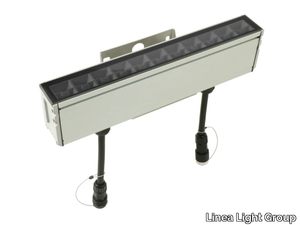
Linea Light Group > Lighting accessories
Here’s a refined and expanded product description with a concise supplier overview and mention of the 3D file availability: **Product Description:** The **ARCHILINE_W ANTI-GLARE Outdoor LED Light Bar** combines high brightness and versatile outdoor installation, backed by years of specialized research. Available in configurations of 11, 22, 33, or 44 LEDs, it offers power ranges from **11.2W DC / 12.5W AC (11 LEDs)** up to **48.5W DC / 54W AC (44 LEDs)**, ensuring adaptable illumination for diverse applications. Crafted from **6060 aluminum alloy** with a **10-micron anodic coating**, the fixture excels in passive heat dissipation and corrosion resistance. Enhanced by **OVP, ESD, TCS®, and AcquaStop®** safety systems, along with a **tempered glass diffuser**, it guarantees durability and performance in outdoor environments. A **3D file of the product is available for download**, facilitating seamless integration into design plans. **Supplier Overview:** Linea Light Group, a globally recognized leader in high-end lighting since 1985, delivers innovative architectural and outdoor lighting solutions, blending Italian design excellence with cutting-edge technology. For more details, visit [www.linealight.com](http://www.linealight.com). *(Note: Adjusted for clarity, technical accuracy, and flow while keeping the supplier description brief yet impactful.)*
XENIA_W PRO - Built-in outdoor aluminium LED light bar _ Linea Light Group
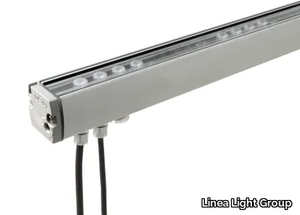
Linea Light Group > Lighting accessories
Here’s the rephrased and expanded product description, including a concise supplier overview and mention of the 3D file: **Xenia_W PRO** is a sleek, recessed aluminum LED bar featuring versatile lighting configurations, including 12 x 7.5W (220 mA), 6 x 8W (450 mA), 12 x 8.5W (500 mA), 12 x 15W (450 mA), and 24 x 17W (500 mA) high-efficiency powerLEDs, delivering optimal illumination for modern architectural and interior spaces. A 3D file of the product is available for download, facilitating seamless integration into design projects. **Supplier Overview:** Linea Light Group, a globally recognized Italian lighting innovator since 1985, specializes in premium, design-forward solutions for residential, commercial, and industrial applications. Explore their portfolio at [www.linealight.com](http://www.linealight.com). This version keeps the supplier description brief while maintaining key details and highlights the 3D file availability. Let me know if you'd like further refinements!
PU_C PLUS - LED strip light _ Linea Light Group
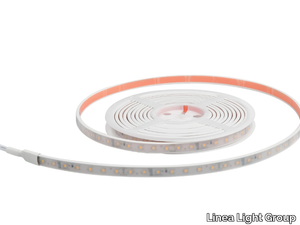
Linea Light Group > Lighting accessories
Here’s the rephrased and expanded product description, including a concise supplier overview and mention of the 3D file availability: *The Ribbon Plus and PU_C ranges provide versatile "Made in Italy" lighting solutions for both indoor and outdoor applications, featuring flexible and adhesive circuits. Options include models with 60 LEDs/metre (available in basic or high-flux versions for enhanced performance), as well as higher-density variants with 120 or 240 LEDs/metre. The collection also includes advanced lighting technologies such as RGBW, Warm Tune, and Dynamic White, complemented by a variety of accessories. Designed for adaptability, these strips can be easily bent or cut to suit specific design requirements. Available light sources include stripLEDs in 16W, 63W, 98W, and 125W (all 24V). A downloadable 3D file of the product is available for further customization and planning. For detailed specifications, refer to the PU_C PLUS line by Linea Light Group—a renowned Italian lighting innovator since 1985, specializing in high-end, design-driven solutions.*
LED strip light - LED strip light _ ONOK Lighting
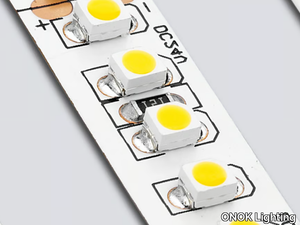
ONOK Lighting > Lighting accessories
Here’s your rephrased and expanded product description, including a concise supplier overview and mention of the 3D file availability: **Product Description:** These high-performance LED strips are ideal for indoor use, with select models (IP62) designed for humid environments, while others (IP20) suit dry applications. For optimal heat dissipation, mounting on an aluminum profile is required. Featuring integrated 3M adhesive tape for easy installation, these energy-efficient strips consume minimal power, reducing operational costs. Available for purchase by the linear meter, the LED strips come in rolls of up to 5 meters. A downloadable 3D file of the product is also available for precise planning and integration. **Supplier Overview:** ONOK Lighting, a trusted Spanish manufacturer since 1993, specializes in premium lighting solutions, combining innovation with high-quality materials for residential and commercial projects. For further details, visit the manufacturer’s website at [onoklighting.com](https://www.onoklighting.com). (Note: Adjust the 3D file link/availability as needed based on actual access.)
ACRUX AC204B-E2 - Light bulb _ Nexia
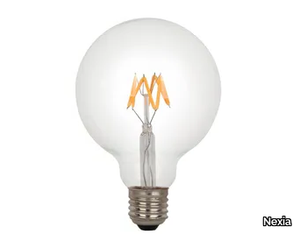
Nexia > Lighting accessories
Here’s a refined and expanded product description, including a concise supplier overview and mention of the 3D file availability: **"This elegant Deco Lamp combines warm, inviting lighting (4W, 2300K, 400lm) with timeless design, perfect for enhancing residential or commercial interiors. A 3D file of the lamp is available for download, allowing seamless integration into your design projects. Supplied by Nexia, a trusted Spain-based interior design brand known for its stylish and versatile lighting, furniture, and décor solutions."** (Note: I condensed the supplier details to one sentence while retaining key credibility points—location, product focus, and reputation.)
MINICONFINE - Floor aluminium Outdoor linear profile _ Ghidini Lighting
Ghidini Lighting > Lighting accessories
Here’s your rephrased and expanded product description, including a concise supplier overview and mention of the 3D file availability: --- This series of linear in-ground recessed luminaires features a shallow recess depth and comes in various sizes, designed to deliver elegant "wall wash" lighting for facades and walls, supported by a wide selection of optics and power options. Crafted for durability and style, the fixture boasts a stainless-steel outer frame for trample resistance and a refined finish, while the high-performance aluminum alloy body—treated with nano-bonderite and textured polyester powder coating—ensures exceptional resistance to oxidation, UV rays, and harsh weather. Silicone gaskets provide superior sealing across all temperatures, and the ultra-transparent tempered glass diffuser, with a silkscreened border, maximizes light output. Equipped with Ghidini’s proprietary water-lock system to prevent cable condensation, the luminaire includes a polypropylene rough-in housing for safe wiring and ground separation. Walkable and suitable for non-traffic areas (though not for pools/fountains), it combines functionality with sleek design. A downloadable 3D file is available for precise planning. *Supplied by Ghidini Lighting, a premium Italian manufacturer celebrated for innovative, high-end lighting solutions.* --- Let me know if you'd like any further refinements!
Ceiling rose - Porcelain ceiling rose _ Ifö Electric
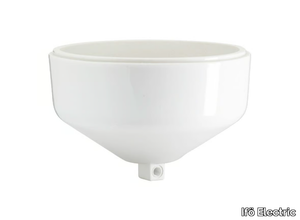
Ifö Electric > Lighting accessories
Here’s a refined and expanded product description, including a concise supplier overview and a mention of the 3D file availability: *"This elegant ceiling rose, crafted from high-quality porcelain, offers a sleek and timeless finish, available in classic white or sophisticated black. Designed to seamlessly complement our Ohm Pendant, Smycka Pendant, or Klack lighting fixtures, it adds a polished touch to any interior. A downloadable 3D file of the product is available for preview or design integration. Manufactured by Ifö Electric—a renowned Swedish lighting specialist known for premium, contemporary designs—this piece reflects their commitment to durability and aesthetic excellence. Explore more at [ifoelectric.com](https://ifoelectric.com/)."* This version keeps the supplier description brief while highlighting key details about the product and its 3D file availability.
KLACK - Porcelain lamp holder _ Ifö Electric
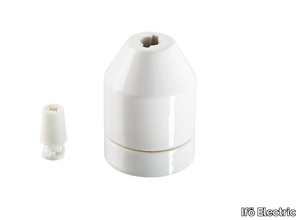
Ifö Electric > Lighting accessories
**Klack** is a minimalist porcelain lamp holder designed with clean, straight lines and a beautifully glazed surface, available in classic white or black. It features an E27 lamp holder compatible with E27 light sources (max 60W, not included) and is rated for 230V with an IP20 protection class and insulation class II, making it ideal for ceiling installation. The luminaire’s versatile design allows you to easily swap the light source, transforming its ambiance. Its name pays homage to the historic kaolin quarry on Lake Ivö, which supplied materials to Iföverken in Bromölla, Sweden, until the 1960s. A 3D file of the product is available for download, offering flexibility for visualization or planning. **Supplier Info:** Ifö Electric is a renowned Swedish lighting brand known for its high-quality, contemporary designs, offering premium lighting solutions for residential and commercial spaces. Explore their collection at [ifoelectric.com](https://ifoelectric.com/).
RETILINE PV EN - Inset polycarbonate Outdoor linear profile _ Exporlux
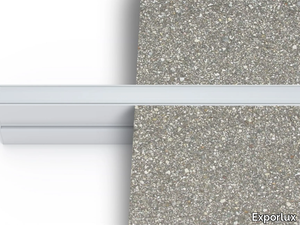
Exporlux > Lighting accessories
Here’s the rephrased and expanded product description, including a concise supplier overview and mention of the 3D file availability: --- **RETILINE PV EN** is a sleek, hermetically sealed recessed luminaire designed for both indoor and outdoor use, combining compact dimensions with a homogeneous, eye-pleasing light output. Ideal for creating modular, continuous-line lighting designs, it excels in applications like path marking or highlighting architectural details. The luminaire features recessed mounting, an opal polycarbonate diffuser, and a durable PVC casting box, and is available in single modules or continuous lines. **Key Features:** - Input Voltage: 24V DC - Dimming: PWM - Options: - **RETILINE PV EN 325**: 2W LED, 3000K/4000K, CRI 80 - **RETILINE PV EN 625**: 3.5W LED, 3000K/4000K, CRI 80 - **RETILINE PV EN 925**: 5W LED, 3000K/4000K, CRI 80 - **RETILINE PV EN 1225**: 7W LED, 3000K/4000K, CRI 80 - Long lifespan: 60,000 hours at L80B10 - **3D file available for download** (check manufacturer’s resources). **Supplier Overview:** Exporlux, a trusted lighting solutions provider since 1989, delivers high-quality, innovative fixtures for residential and commercial projects, with a global presence spanning Europe. For more details, visit [Exporlux’s website](http://www.exporlux.pt). --- This version keeps the description engaging and informative while streamlining the supplier details and highlighting the 3D file availability. Let me know if you'd like any further refinements!
LED DRIVER AC/48V DC - LED power supply _ Terzo Light

Terzo Light > Lighting accessories
Here’s a rephrased and expanded product description, including a concise supplier overview and mention of the 3D file availability: **Product Description:** The **LED Driver AC/48V DC** is a high-efficiency power supply designed specifically for the **TRACK 48V** series of track lights, offering reliable performance with wattage options of **100W or 350W** to suit different lighting needs. Detailed specifications can be found in the manufacturer's documentation. A **3D file of the product is available for download**, enabling seamless integration into design plans. **Supplier Overview:** Terzo Light is a trusted lighting solutions provider known for its high-quality, stylish fixtures for residential and commercial spaces. Let me know if you'd like any further refinements!
BACKPLATE 3 - Steel lamp holder _ Astro Lighting

Astro Lighting > Lighting accessories
Here’s your rephrased and expanded product description, including a concise supplier overview and mention of the 3D file: *The Backplate 3 is a sleek, steel lamp holder with a white finish, designed for use with E27/ES bulbs (max 60W). Rated IP20, it is suitable for bathroom Zone 3 and features a Class I earthed design for safety. A downloadable 3D file of the product is available for detailed planning and integration. For additional specifications, refer to the manufacturer’s details on Astro Lighting’s Backplate 3.* **Supplier Overview:** *Astro Lighting, a UK-based leader in innovative interior and exterior lighting since 1997, combines modern design with high-quality craftsmanship.* Let me know if you'd like any further refinements!
UPHOLSTERY
A wide range of Upholstery and materials provided by our suppliers to satisfy your needs.
AI services
Fringe Chatbot | Image Finder | Fringe Dall-e | Area Analyzer



